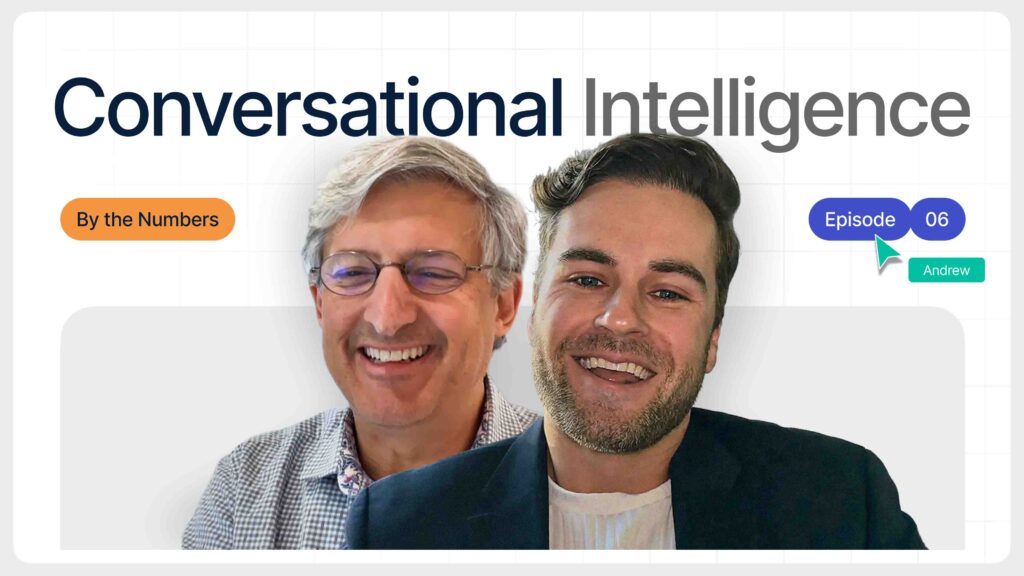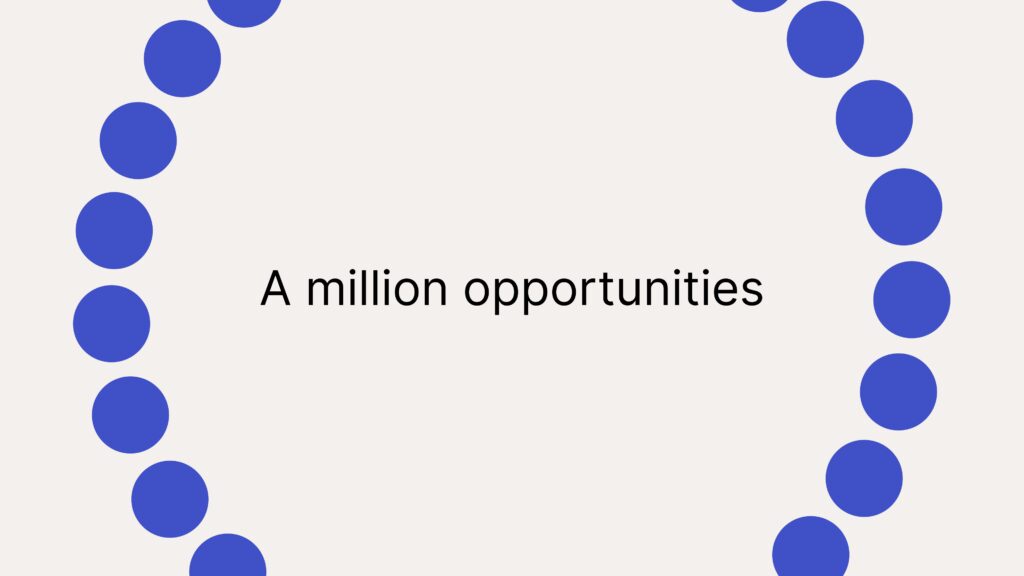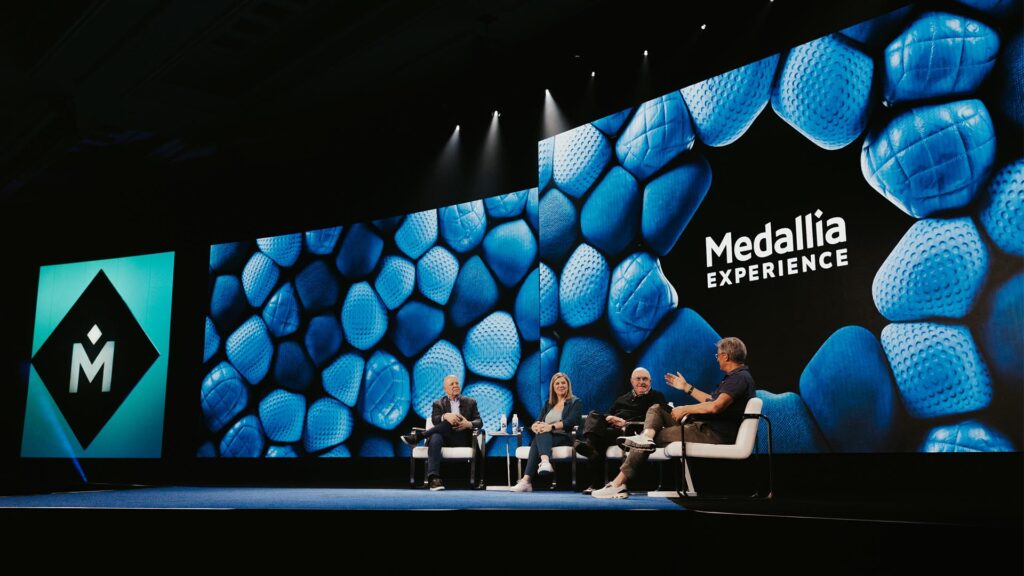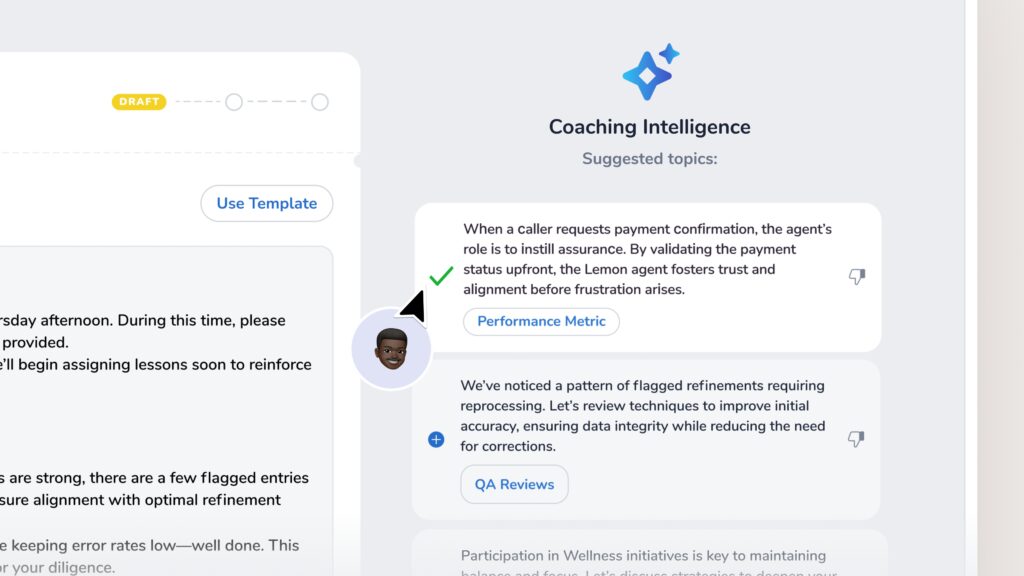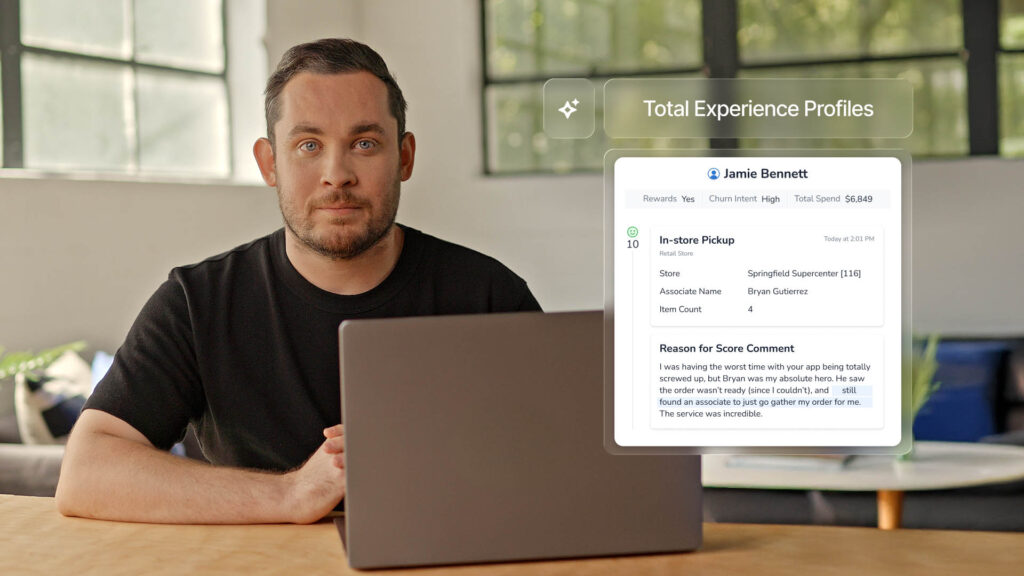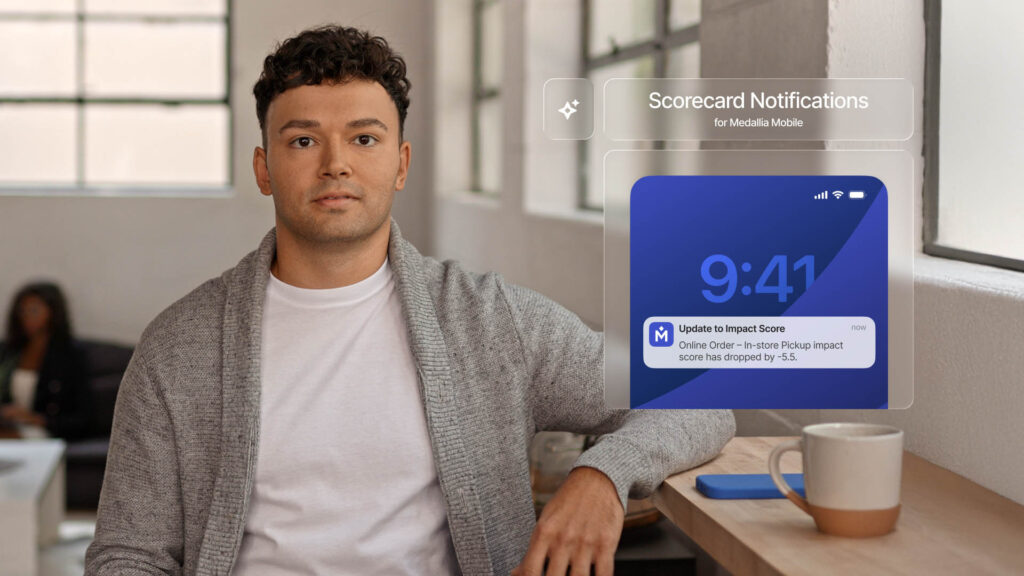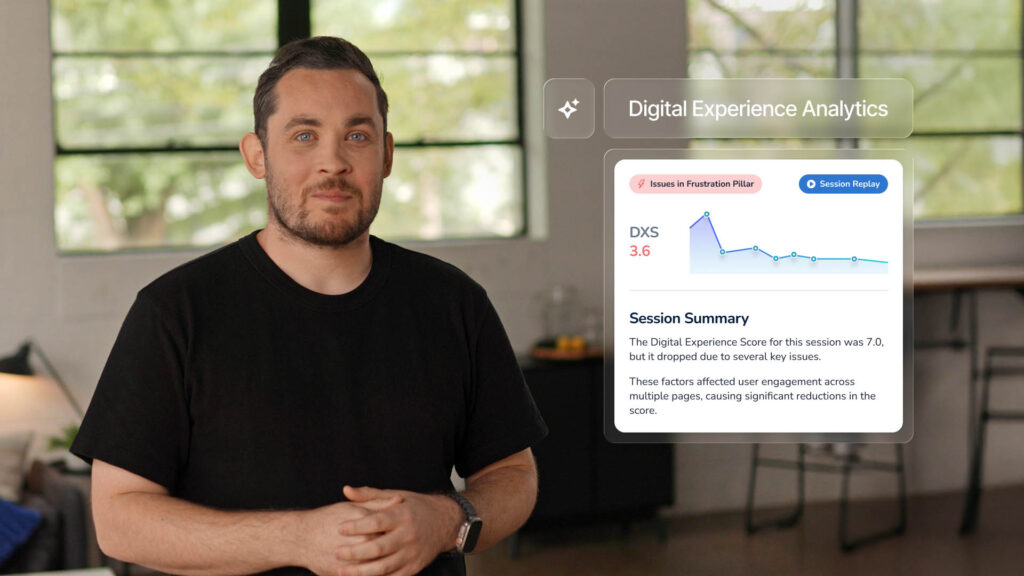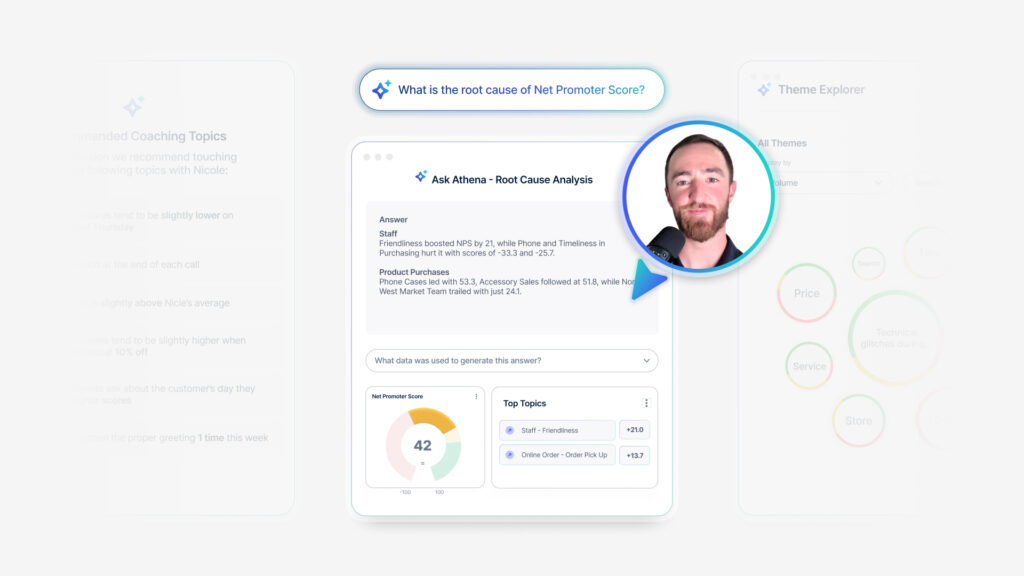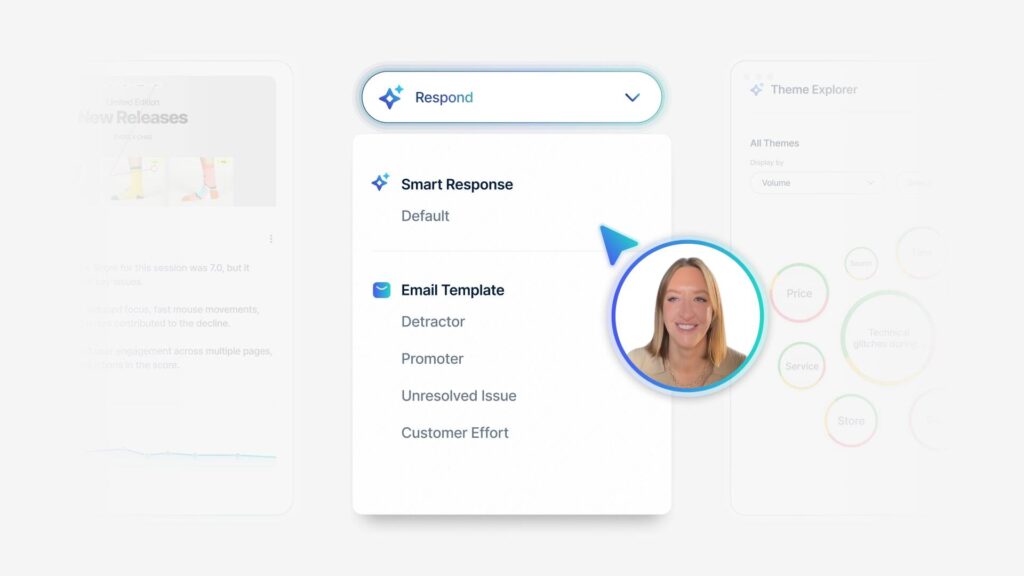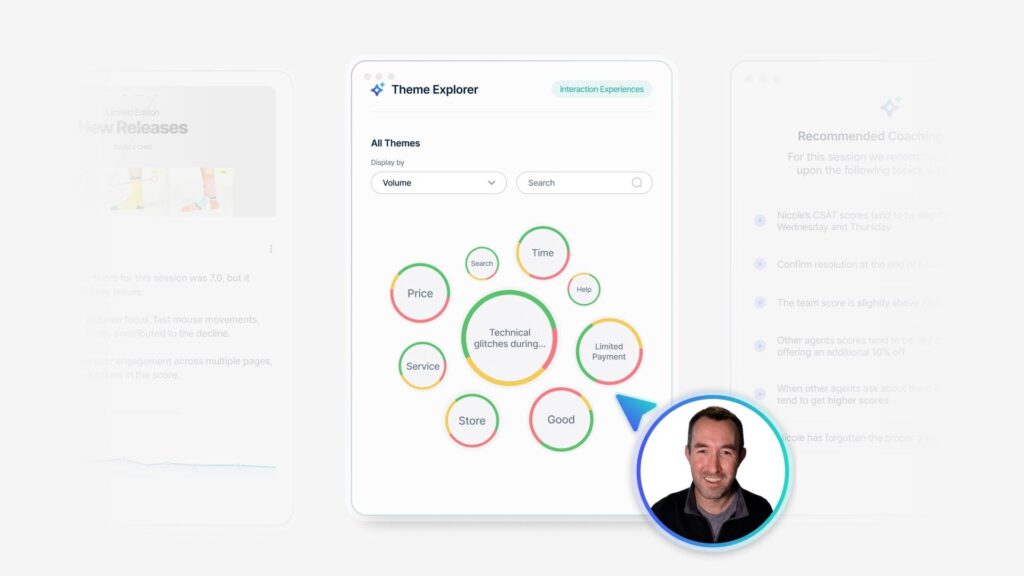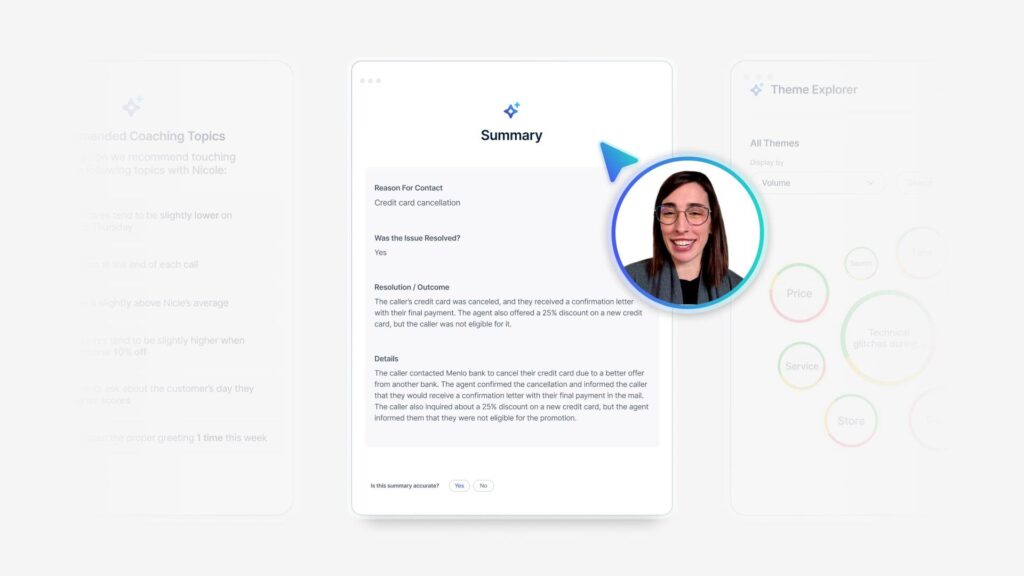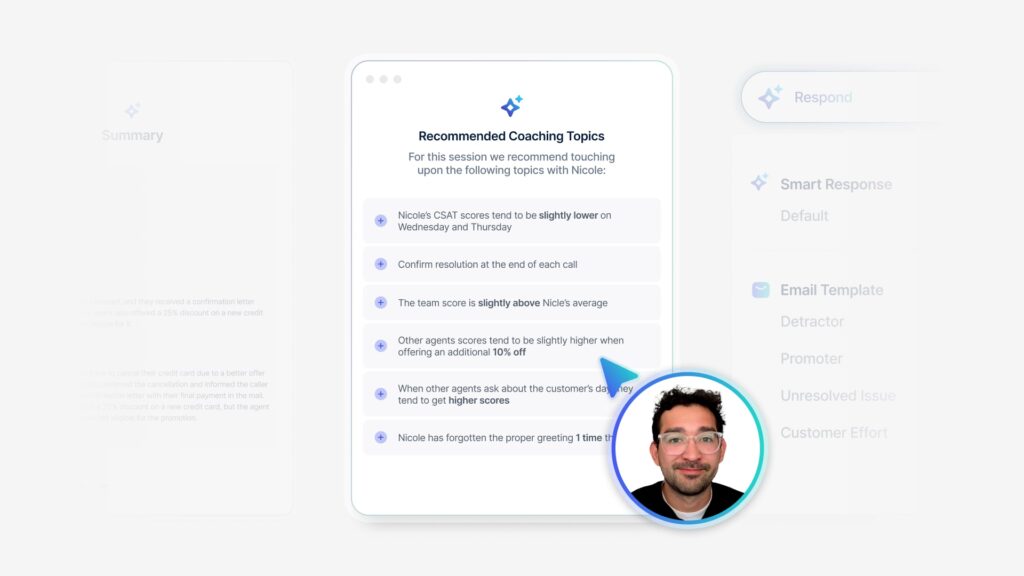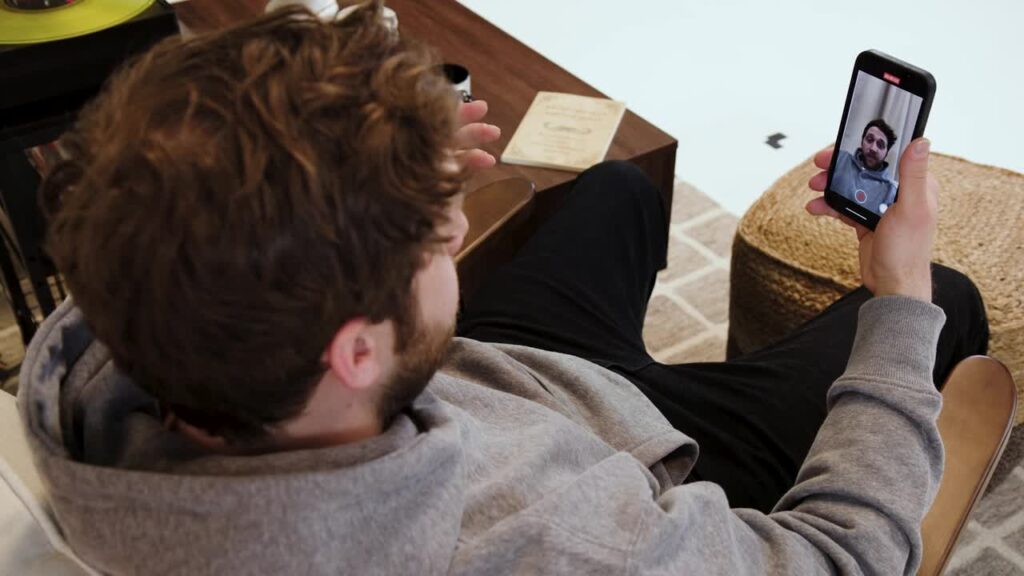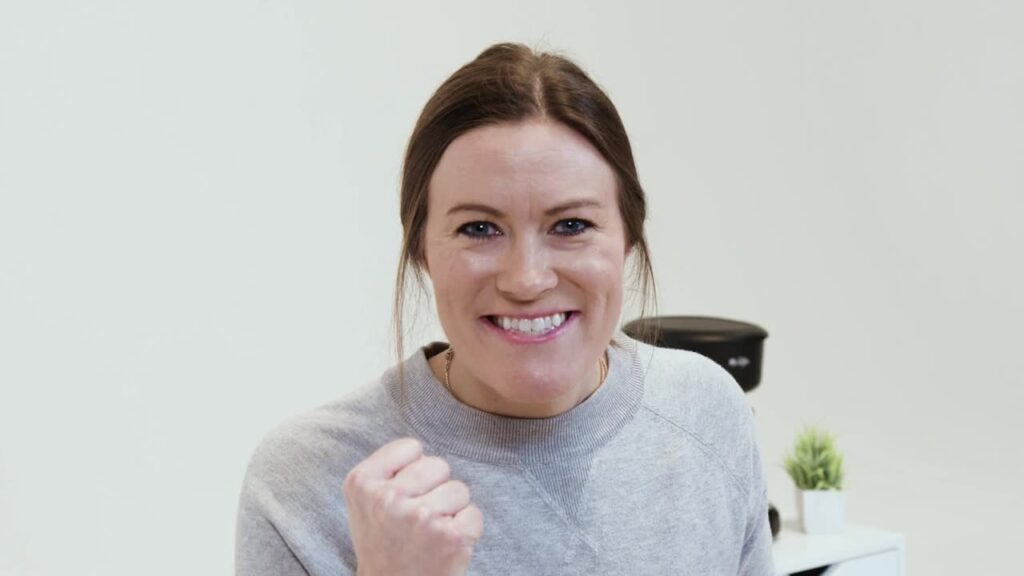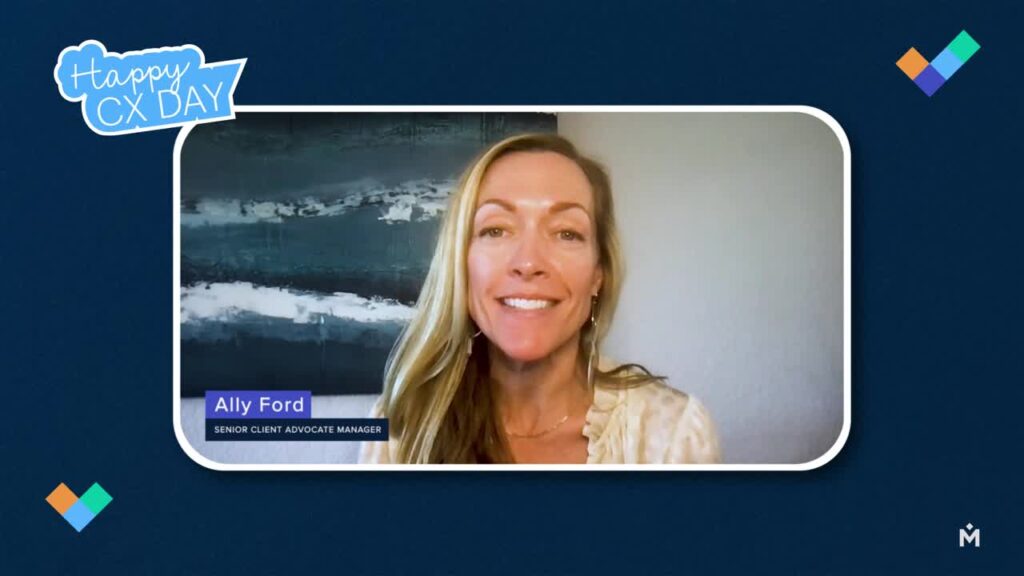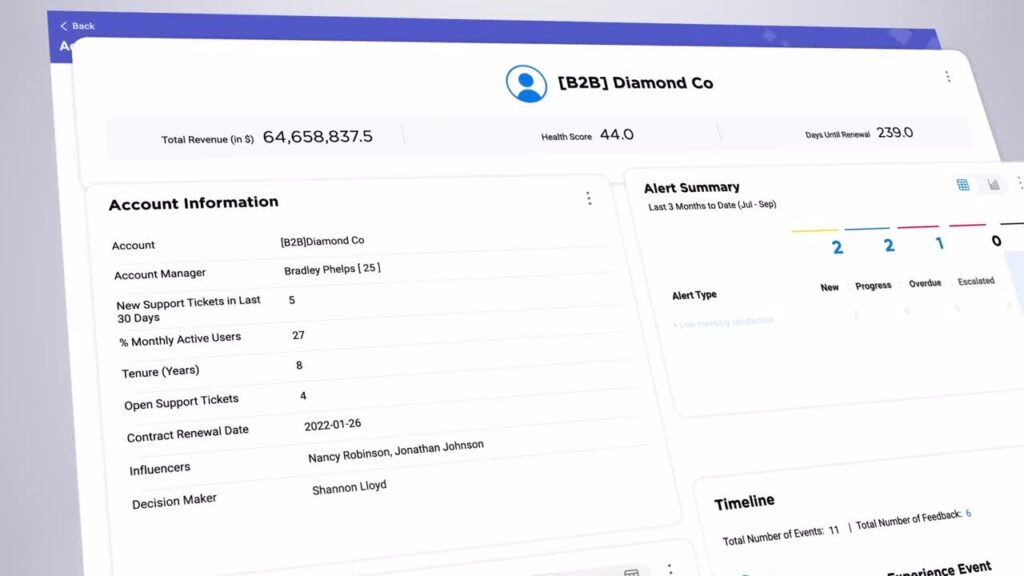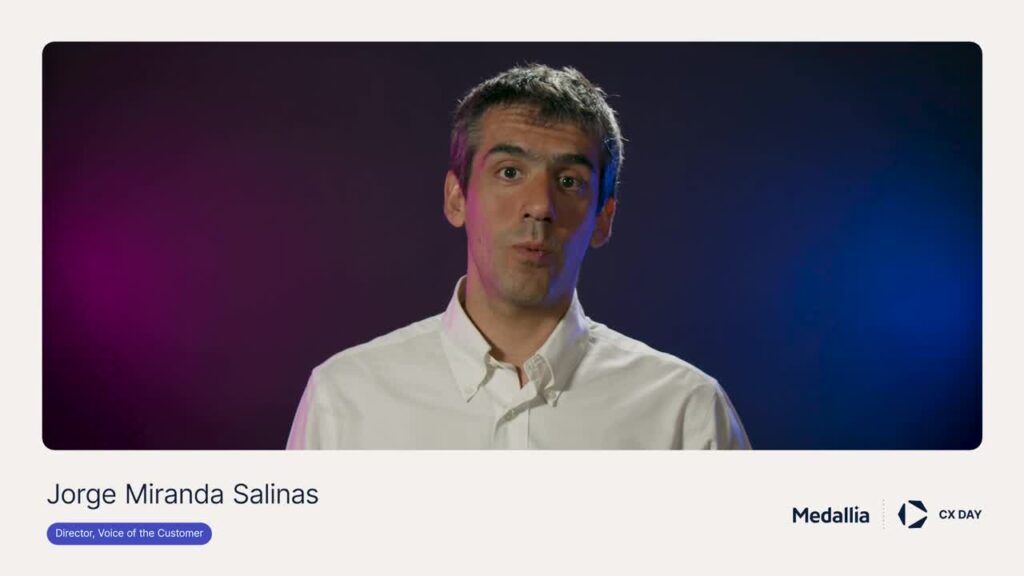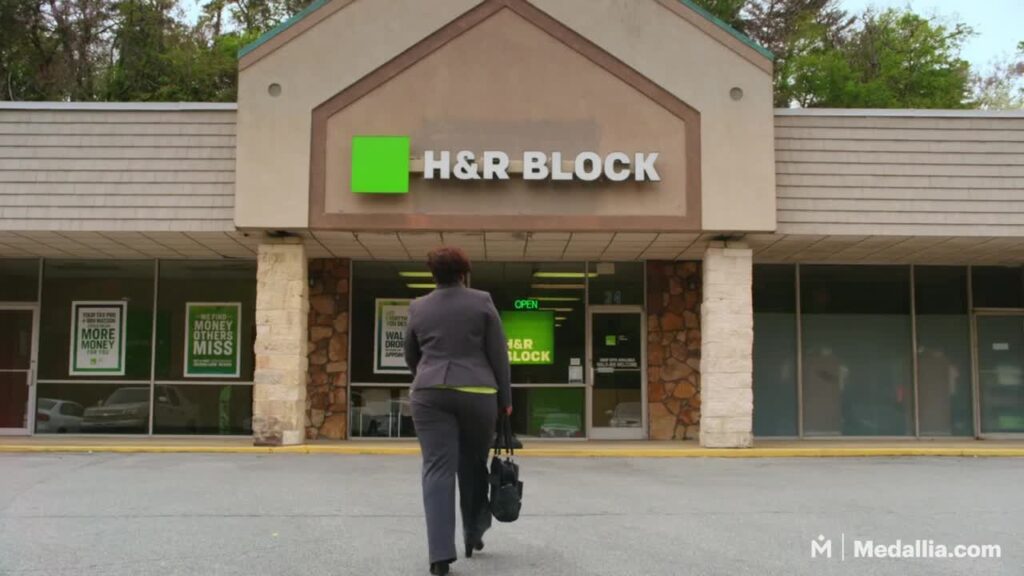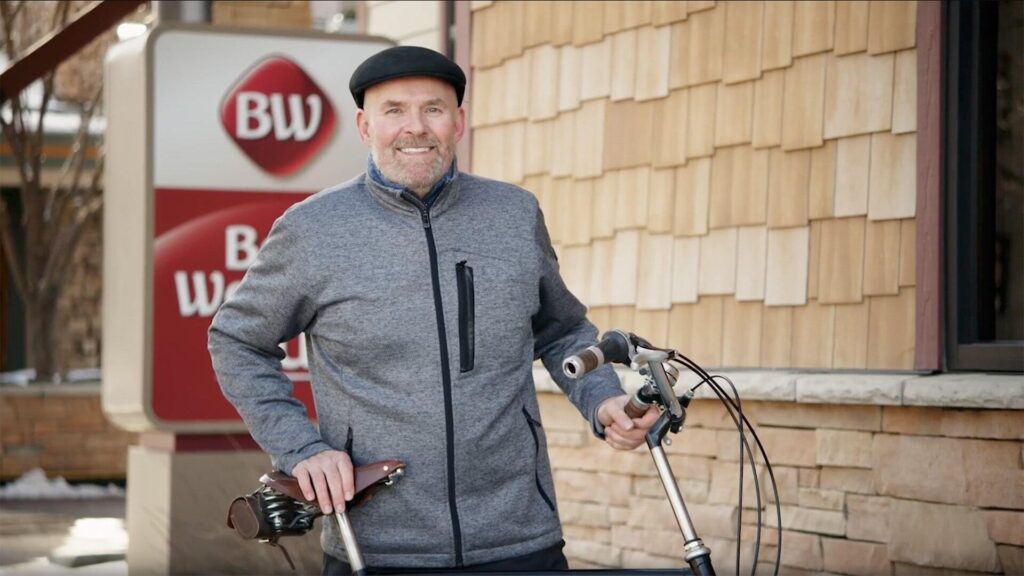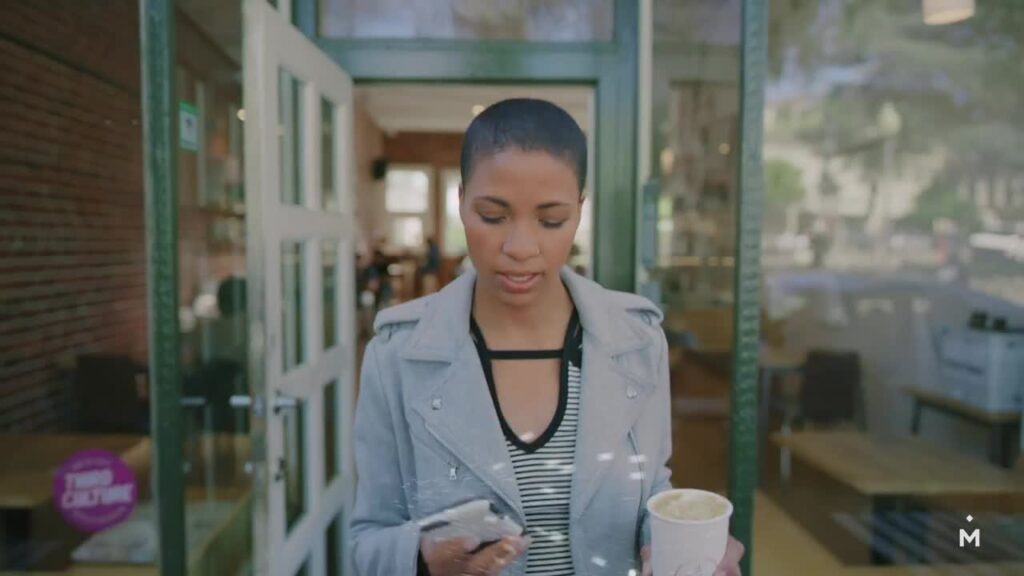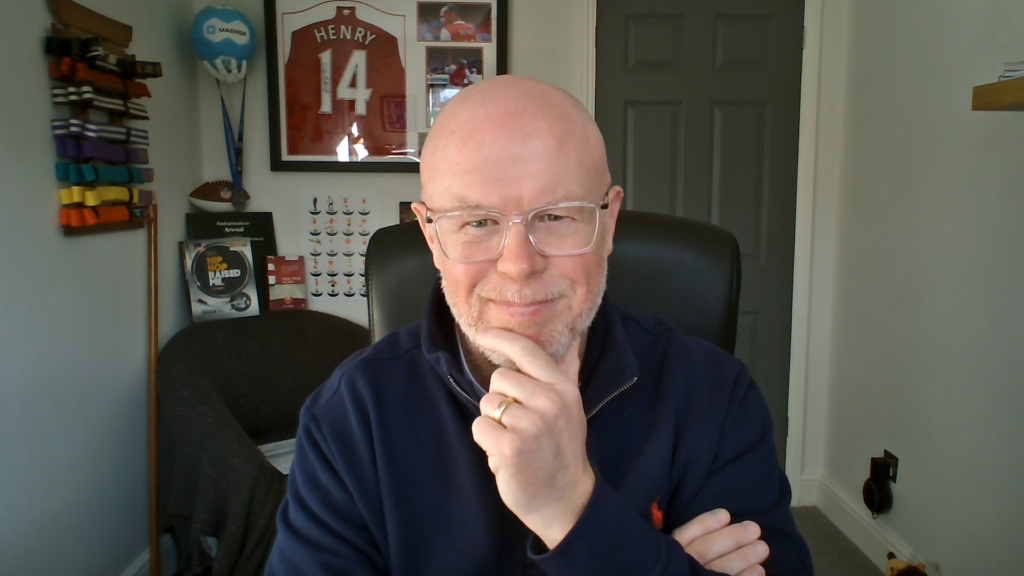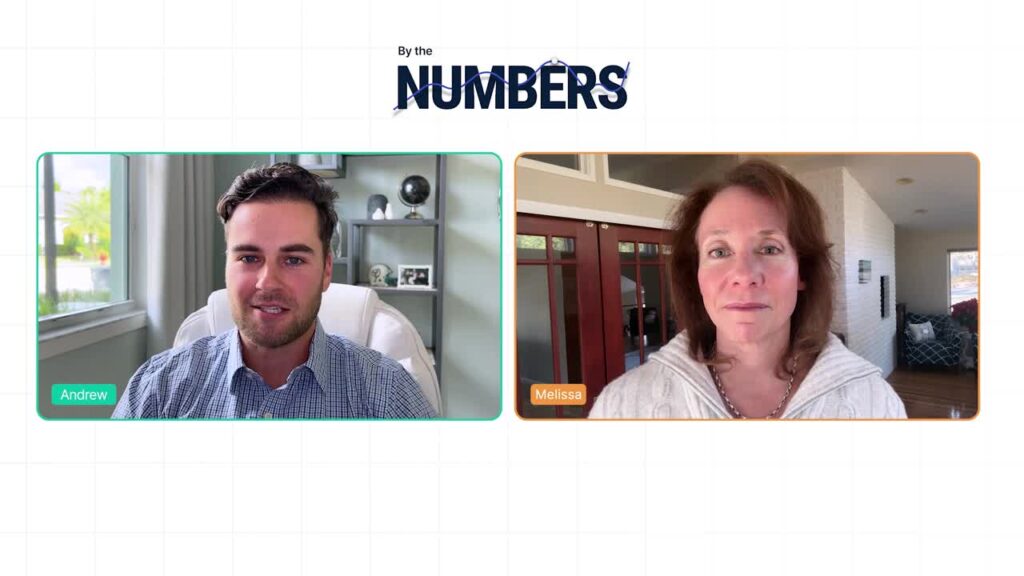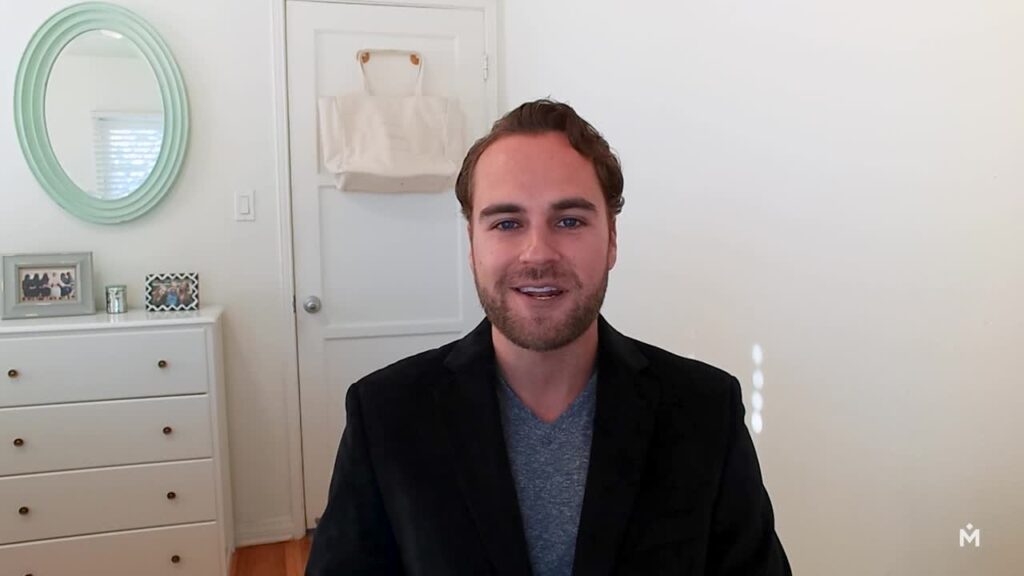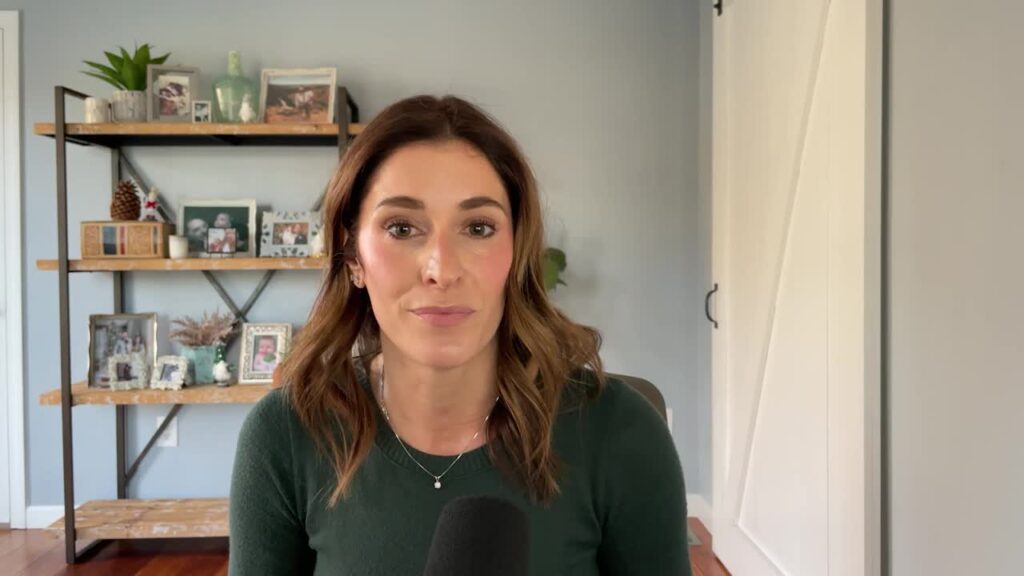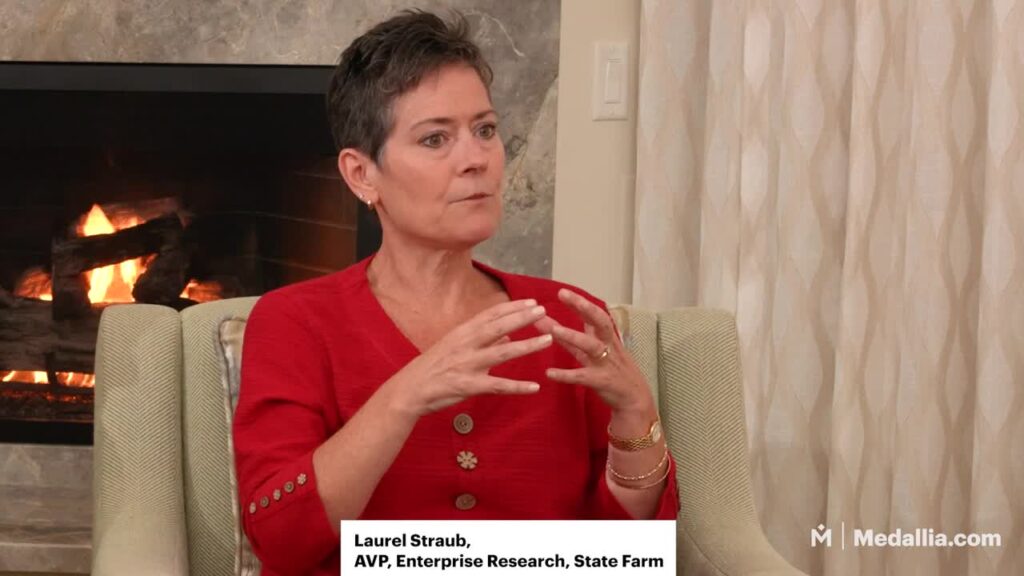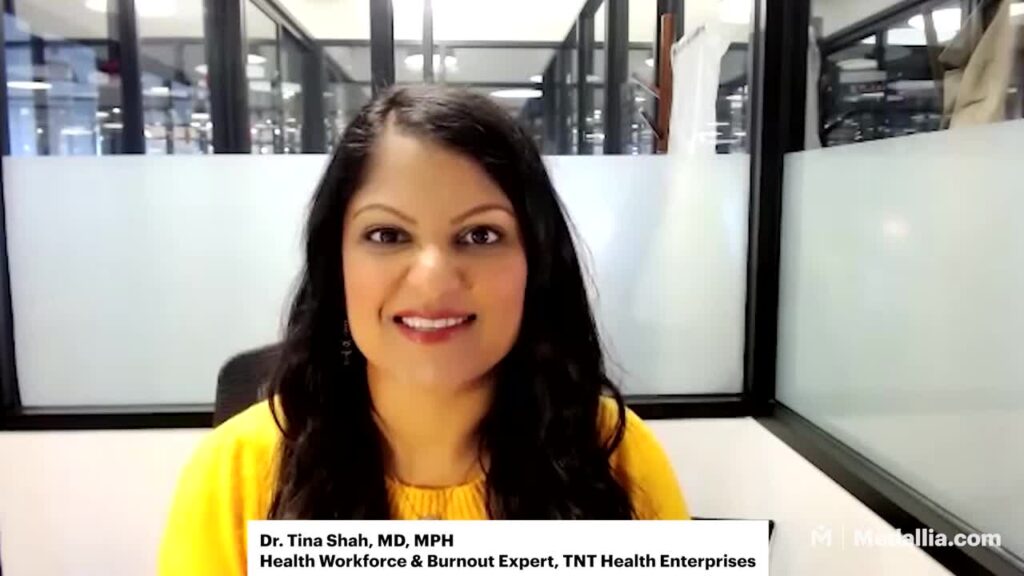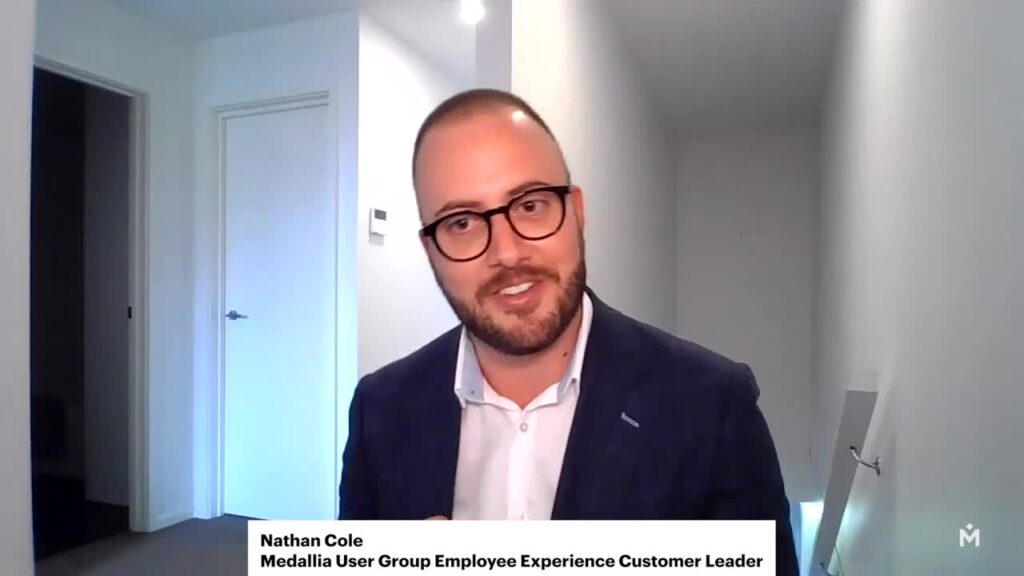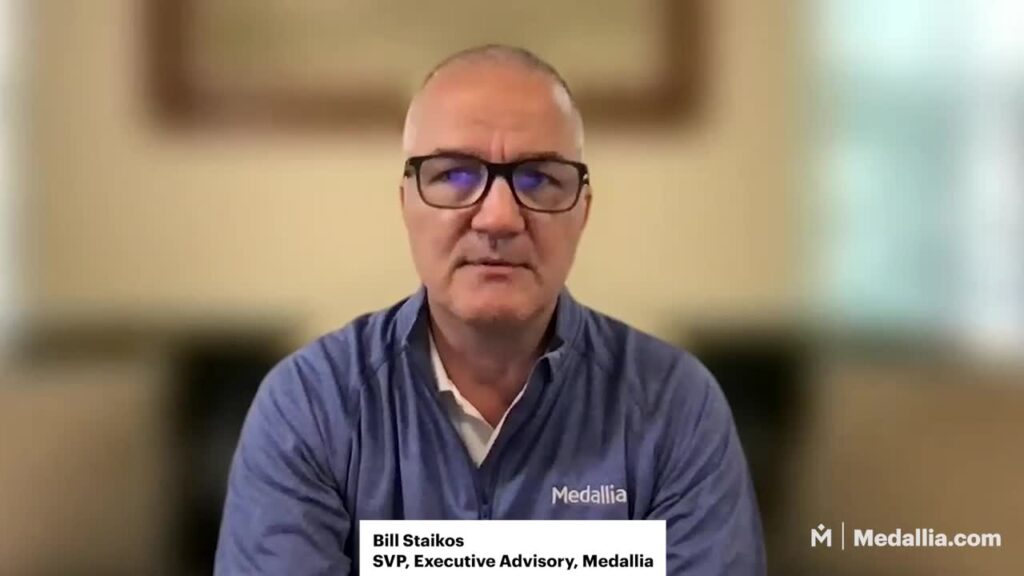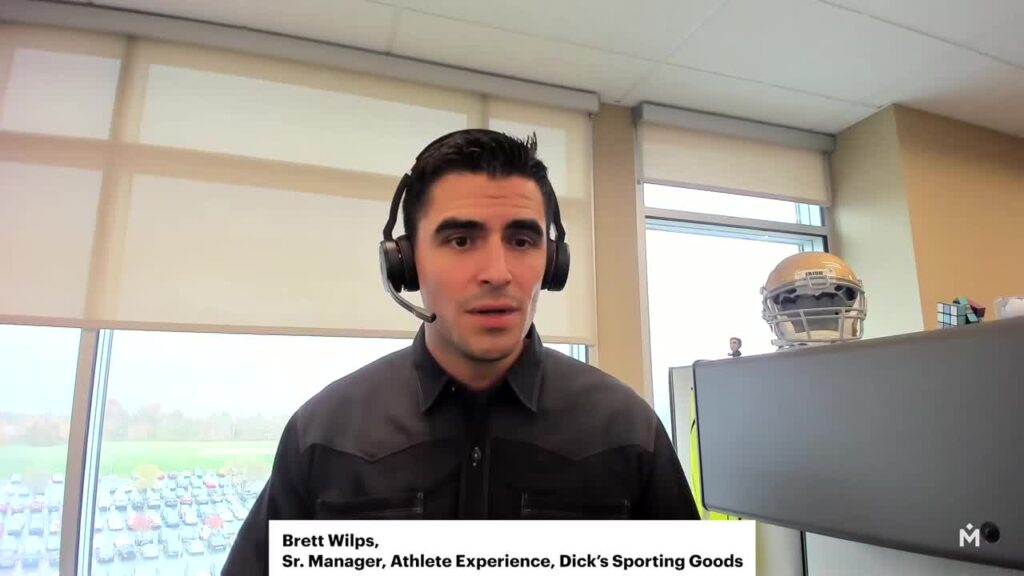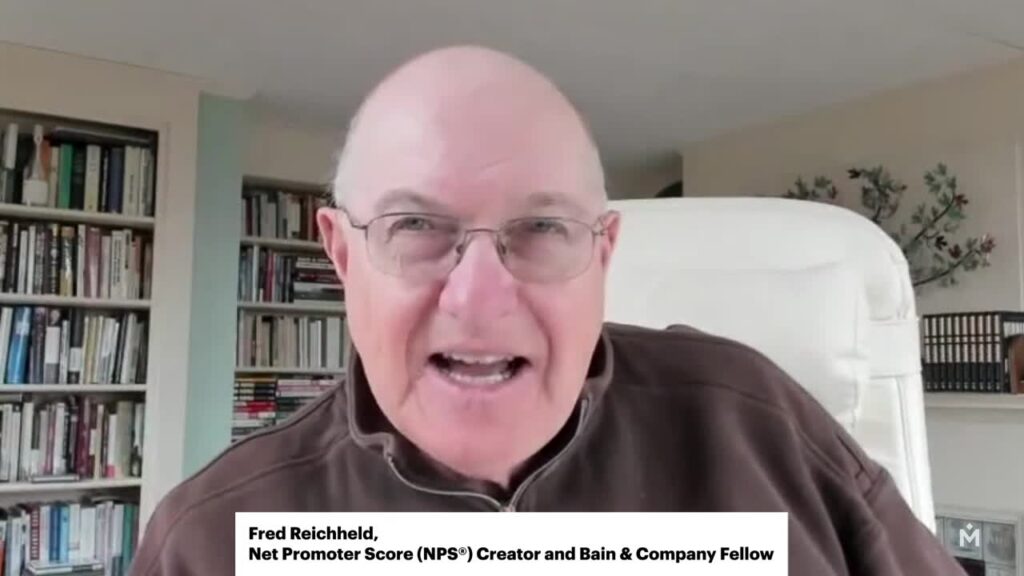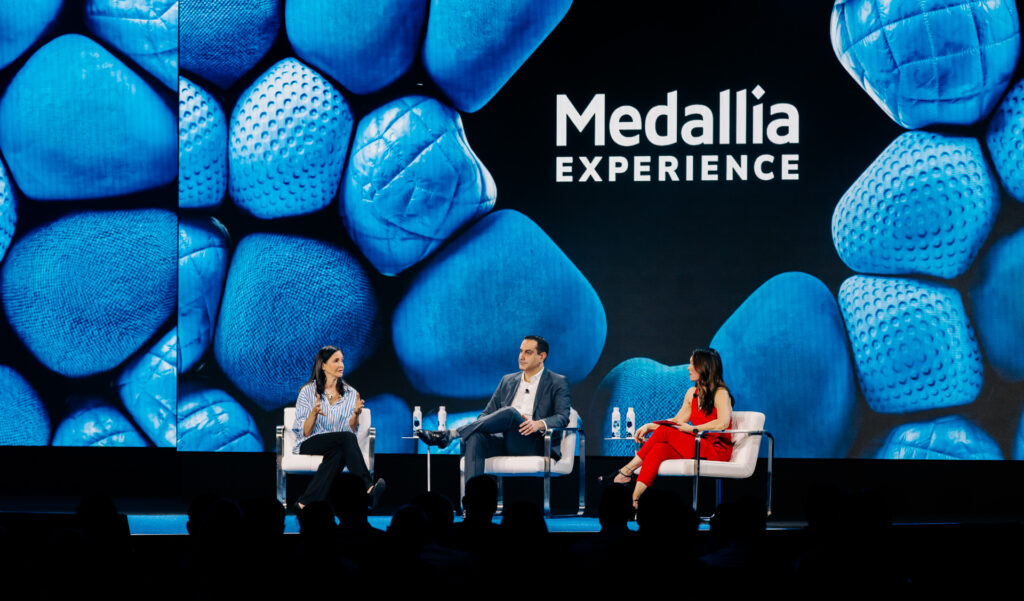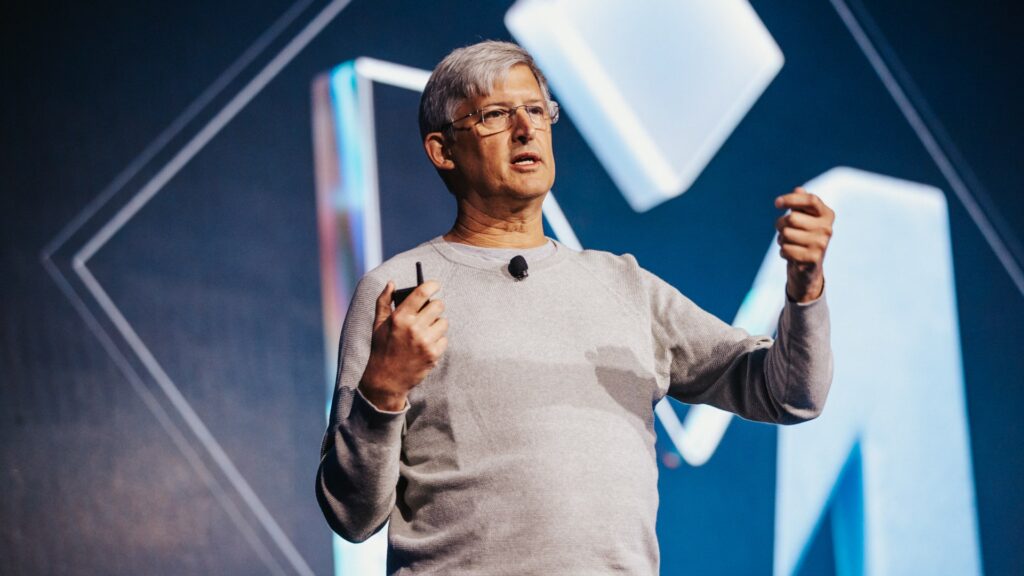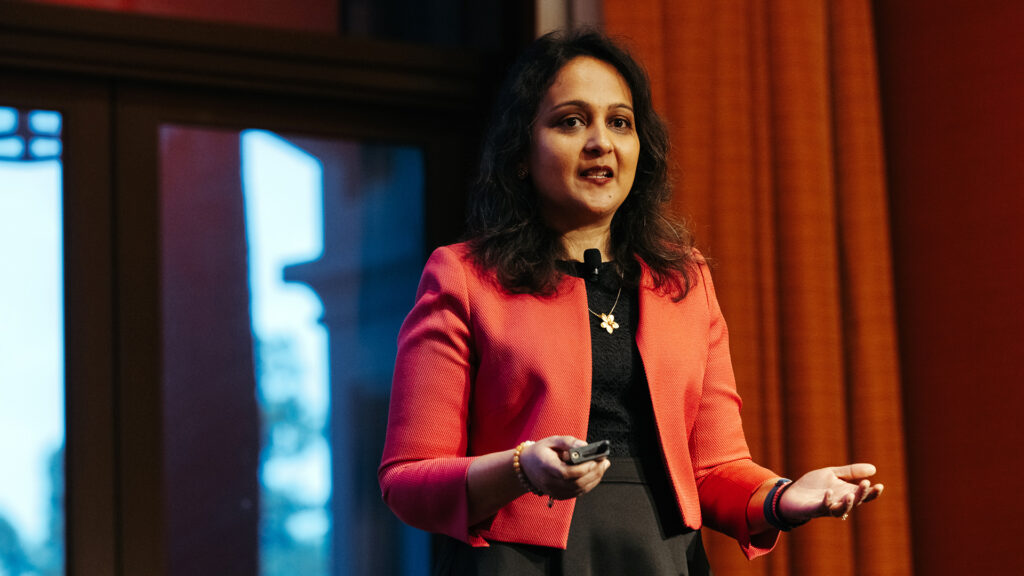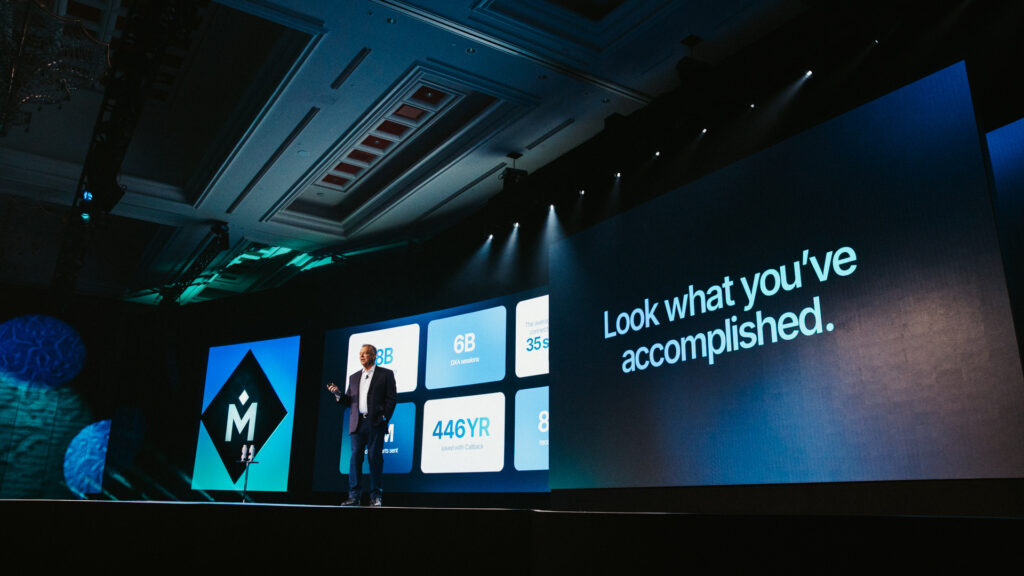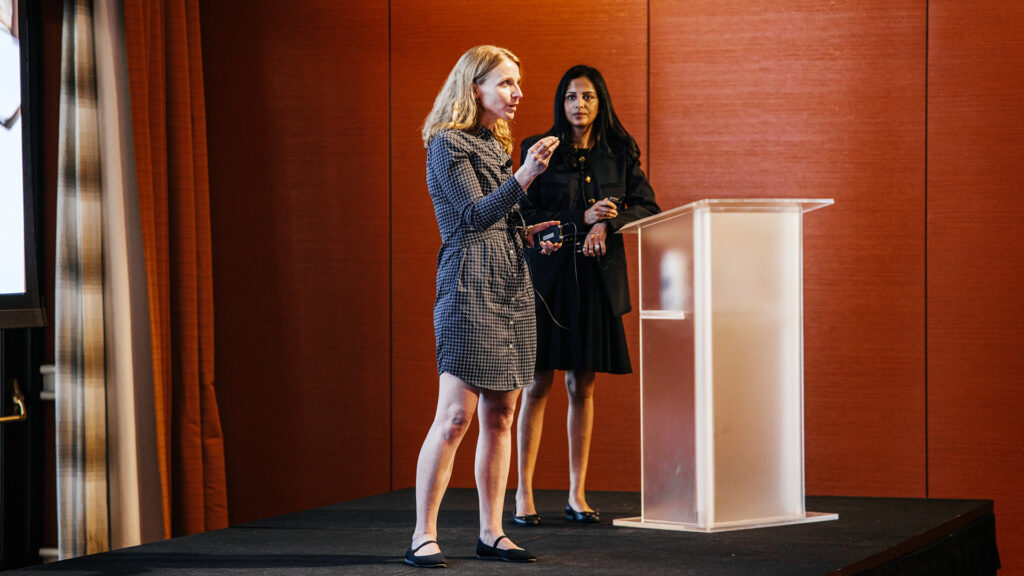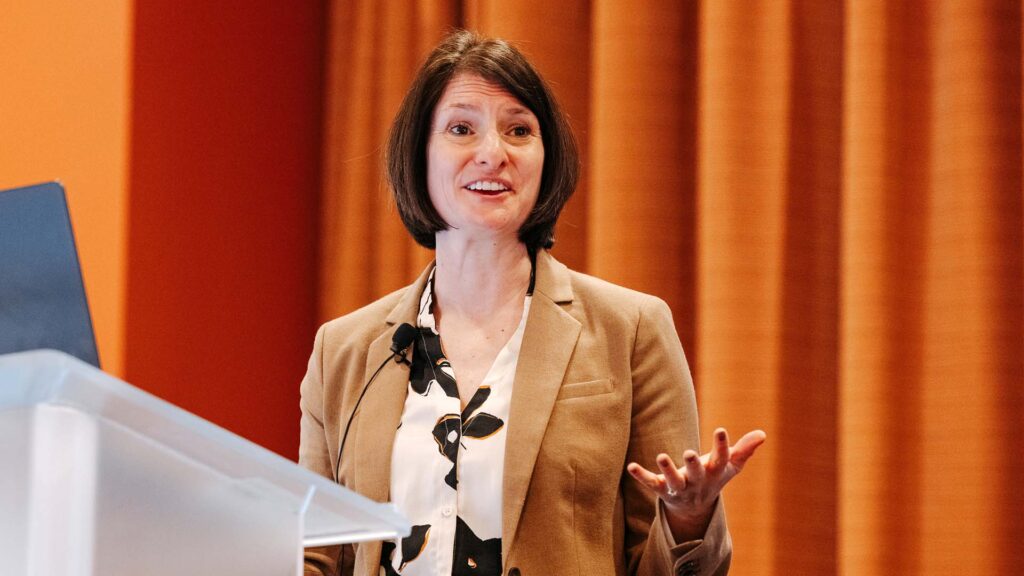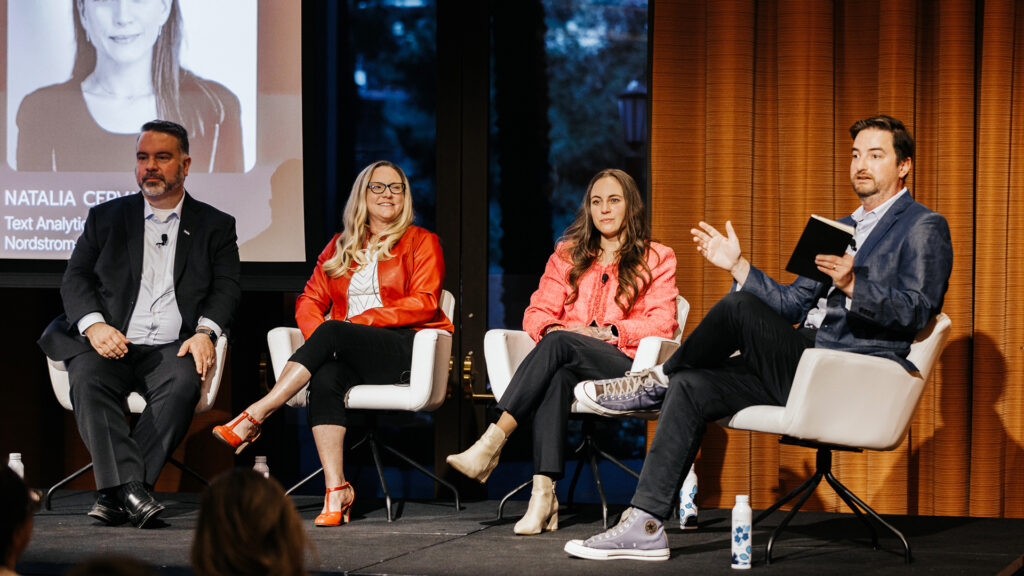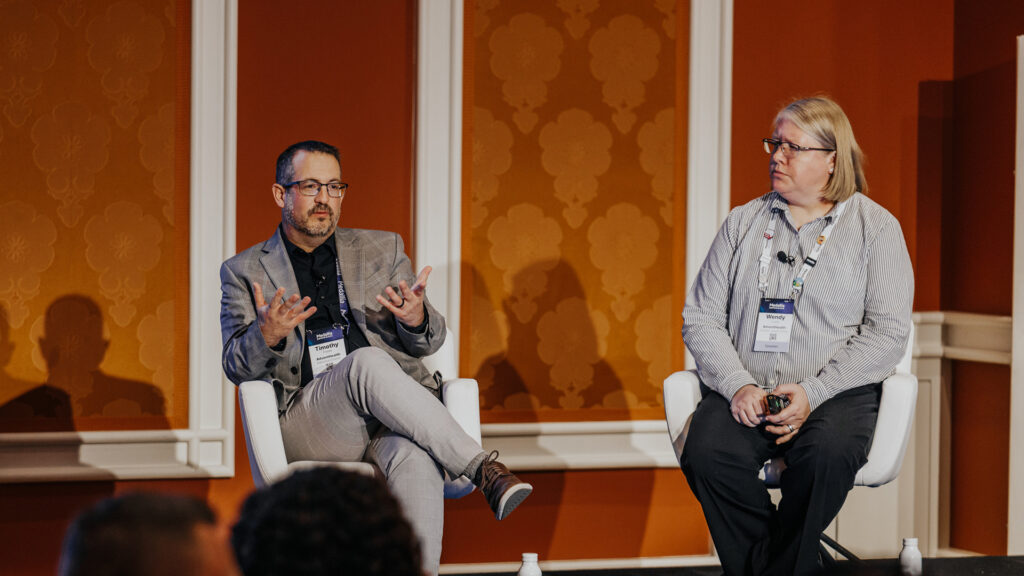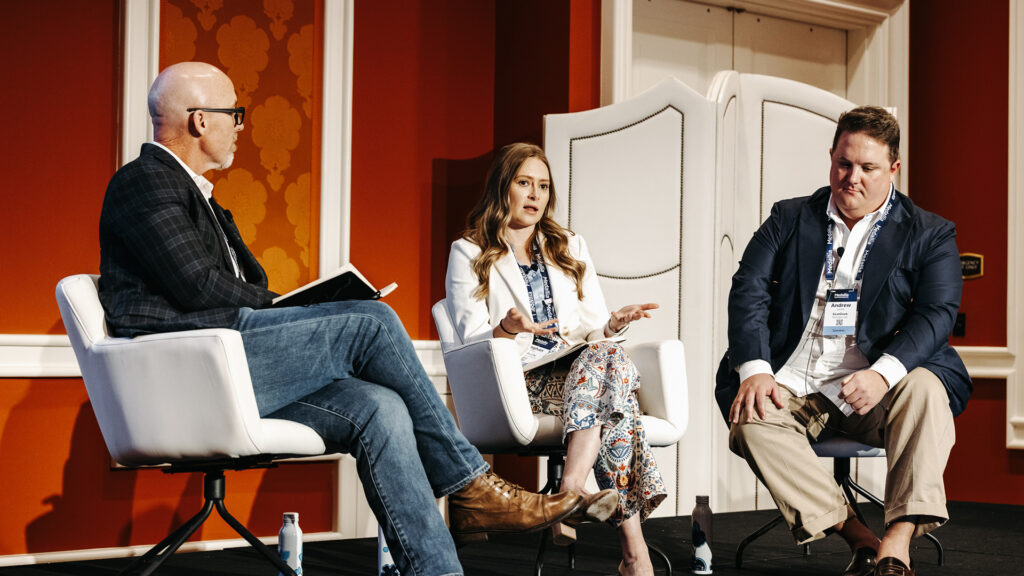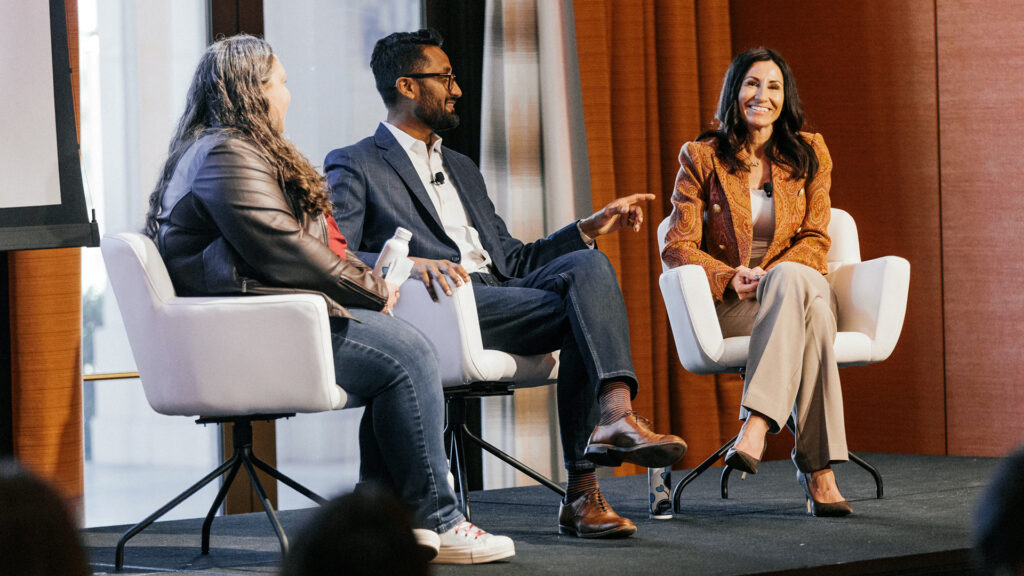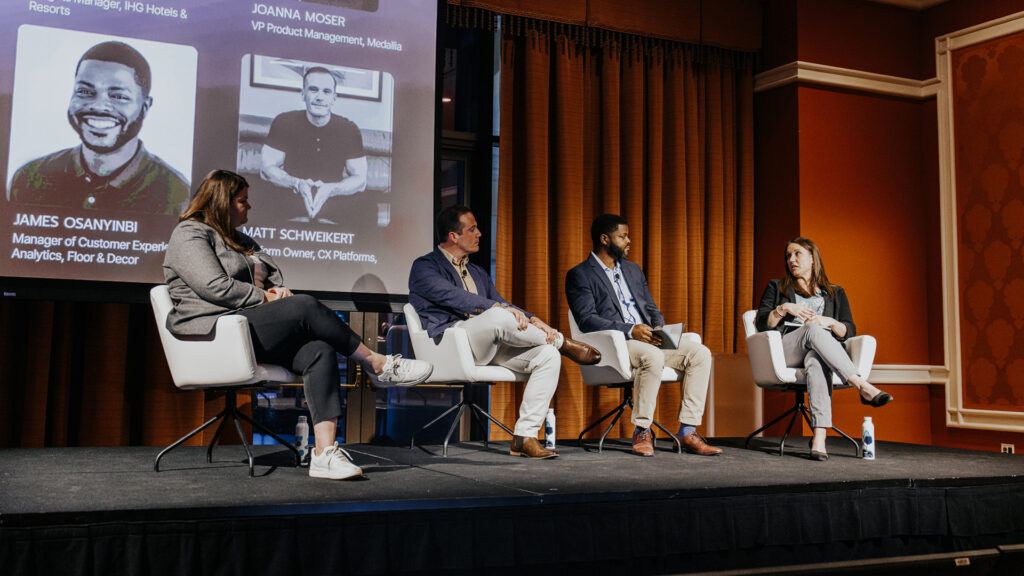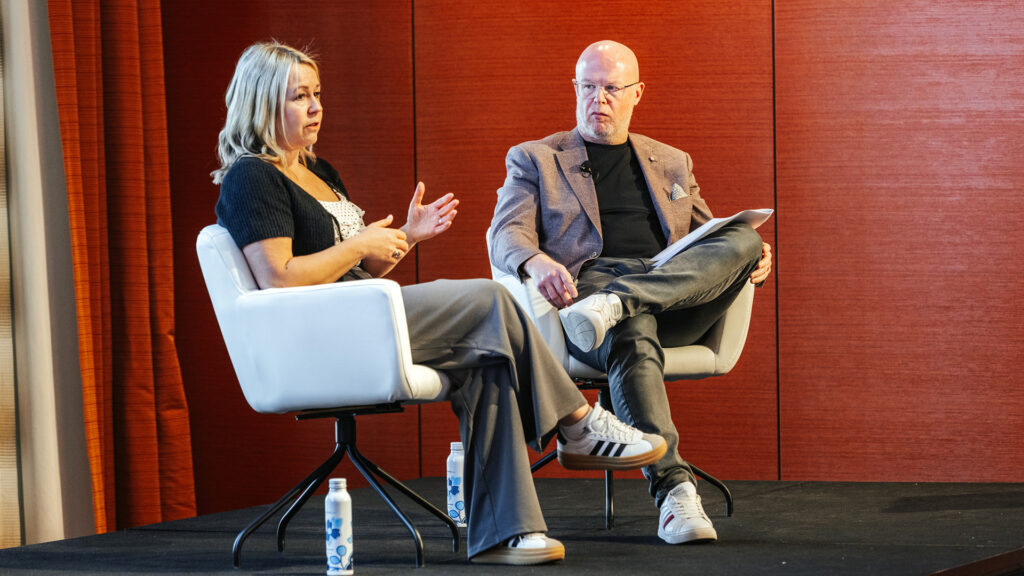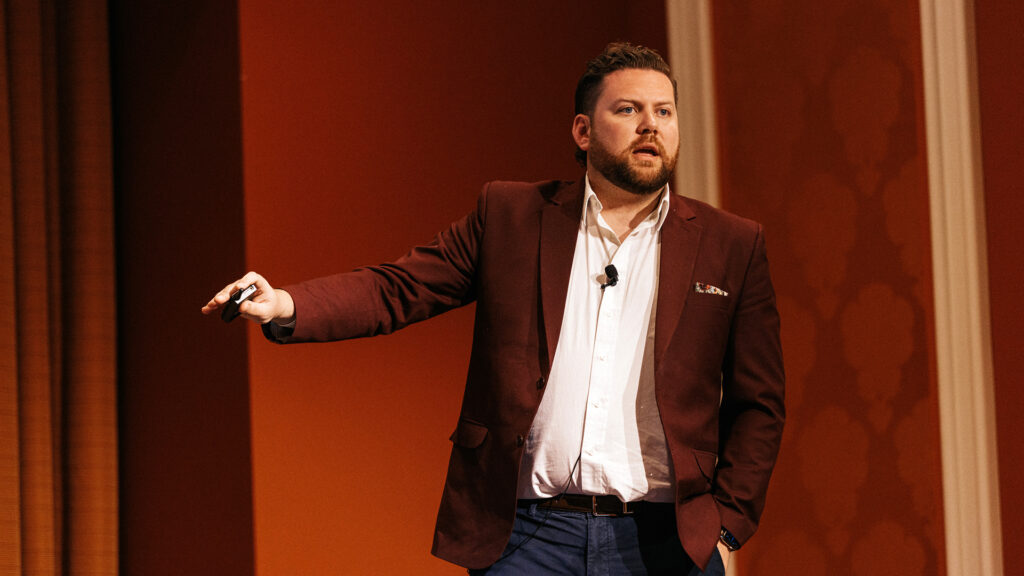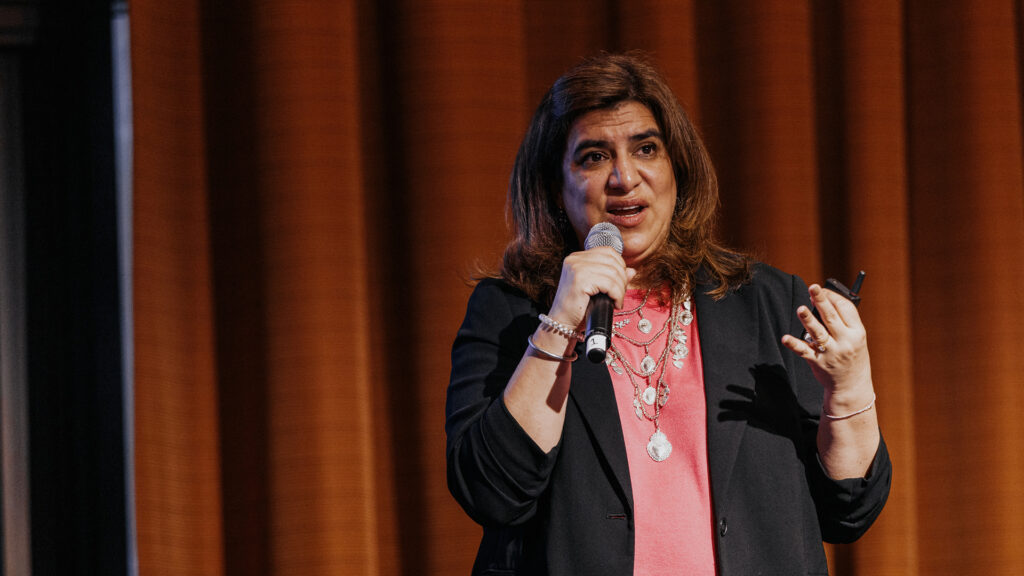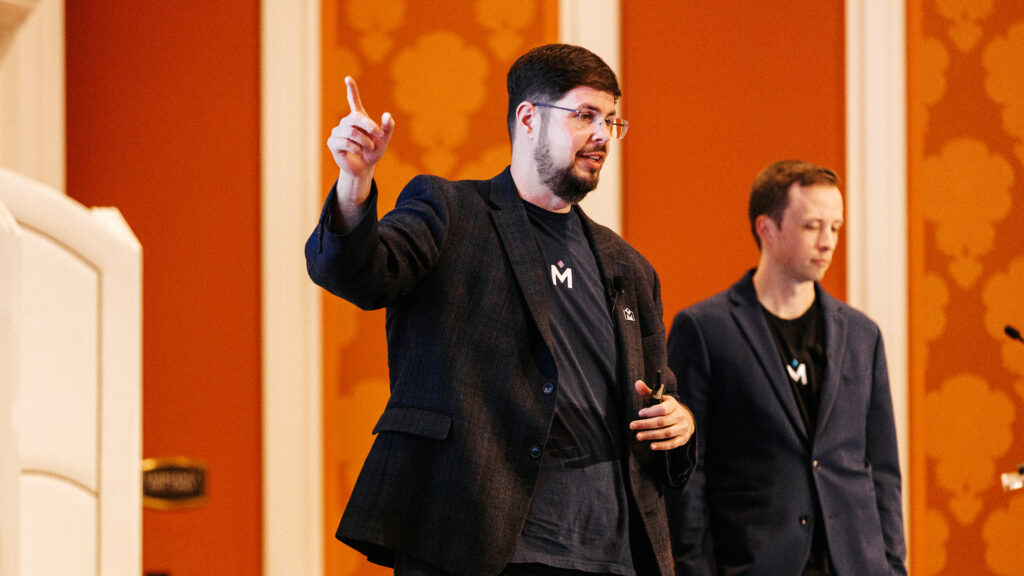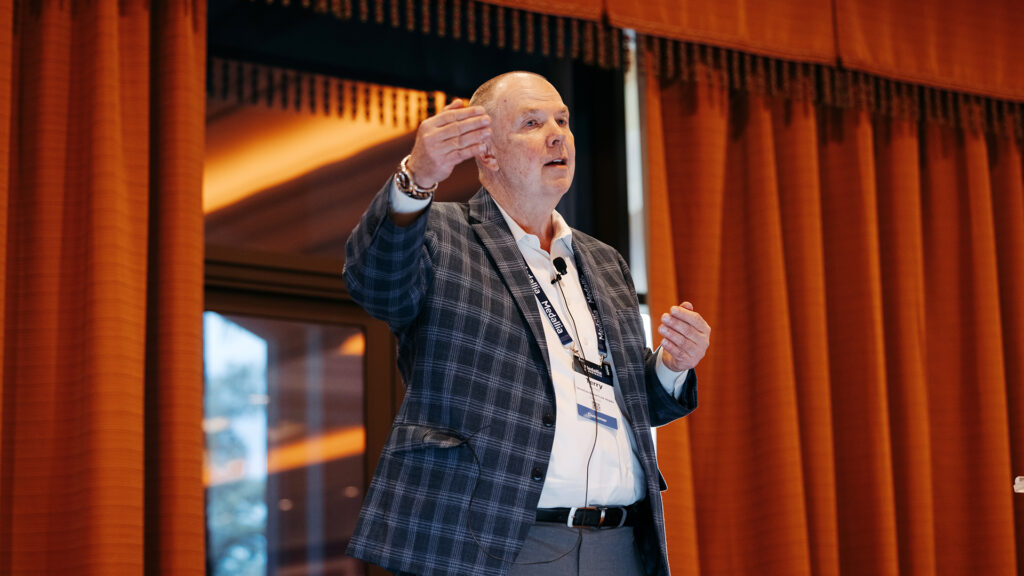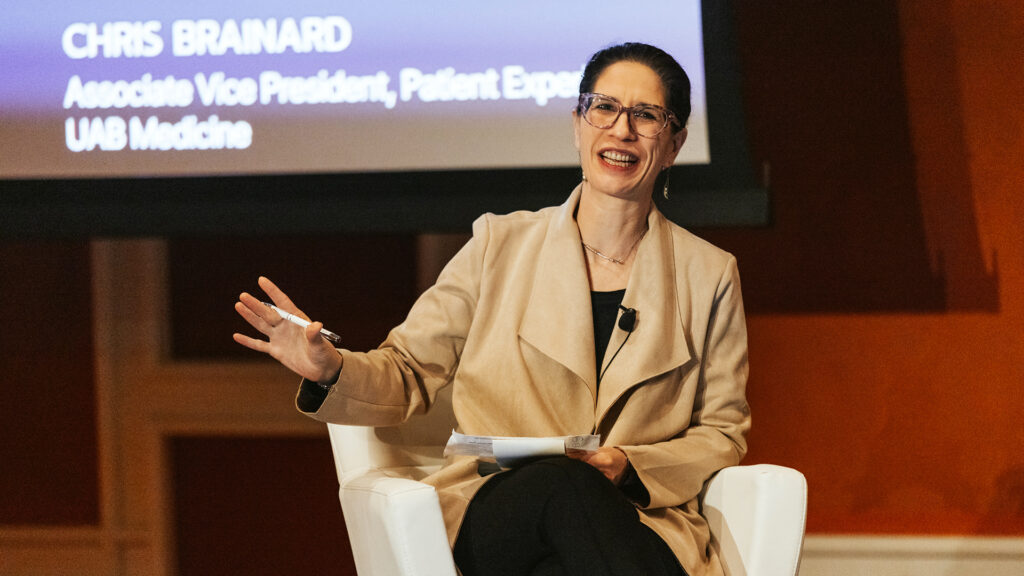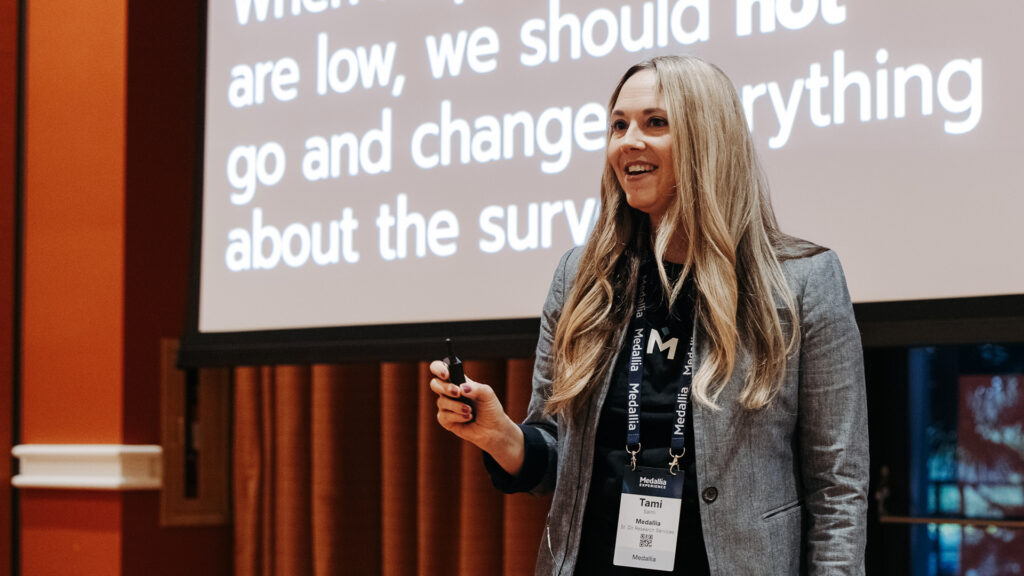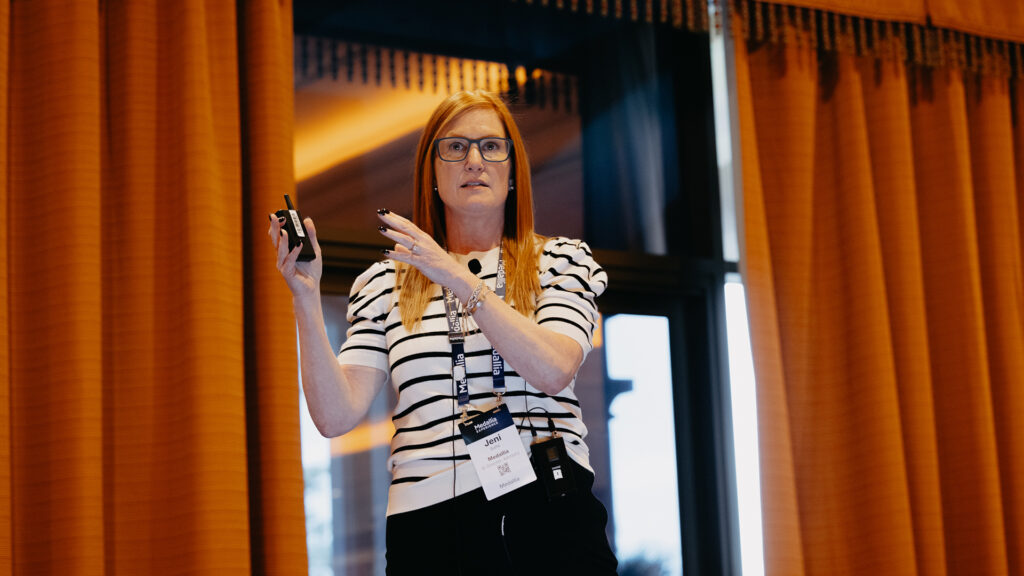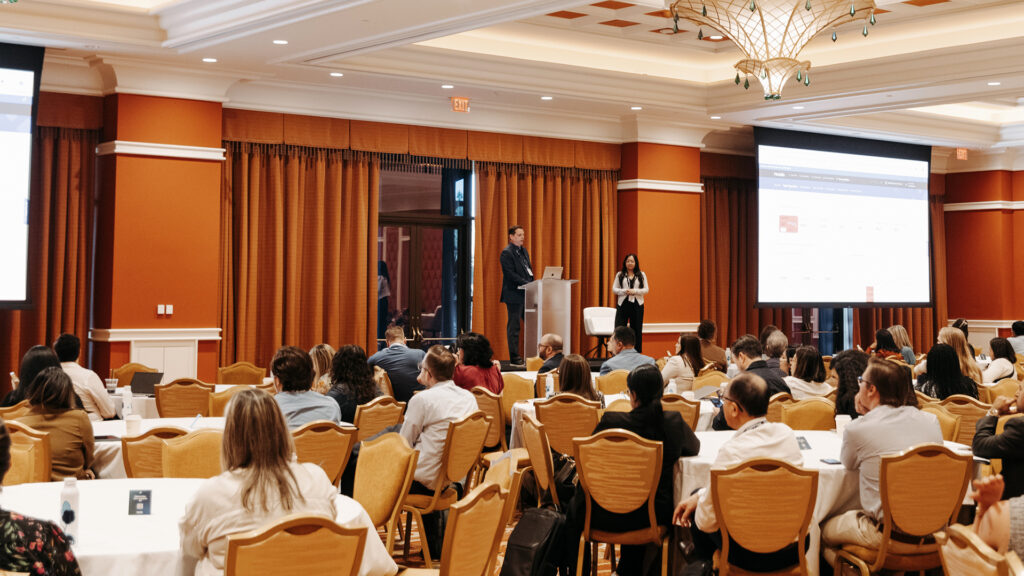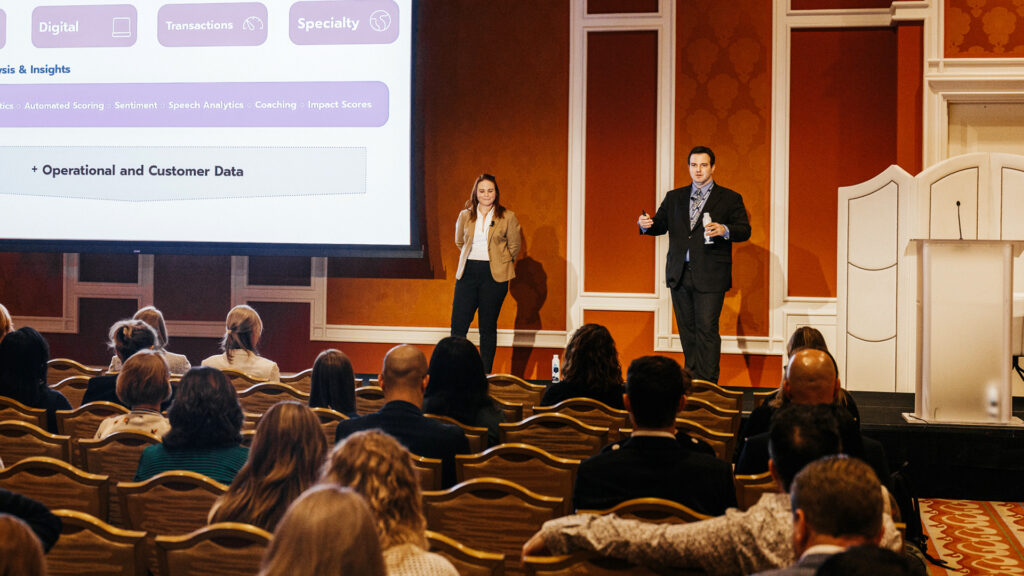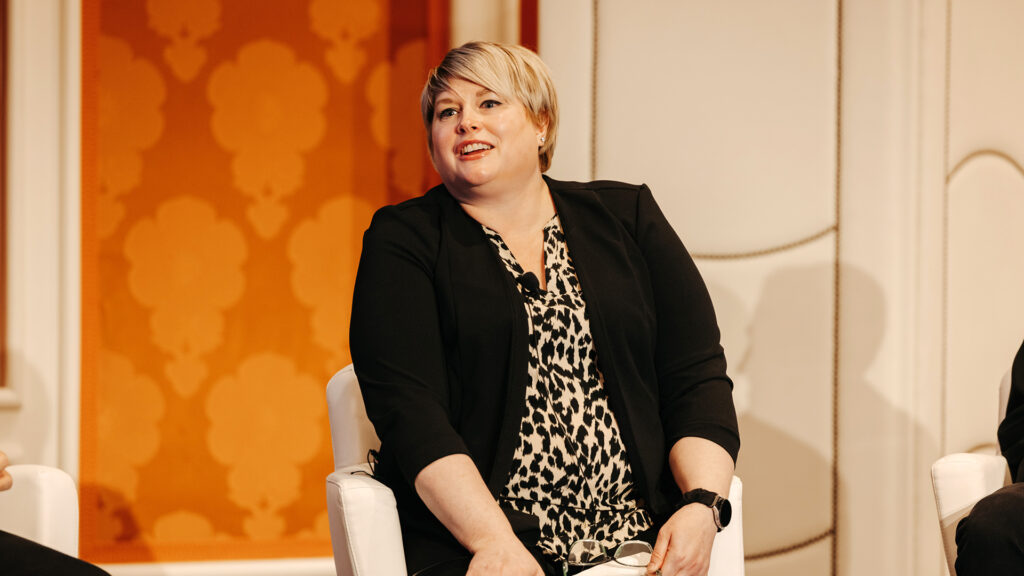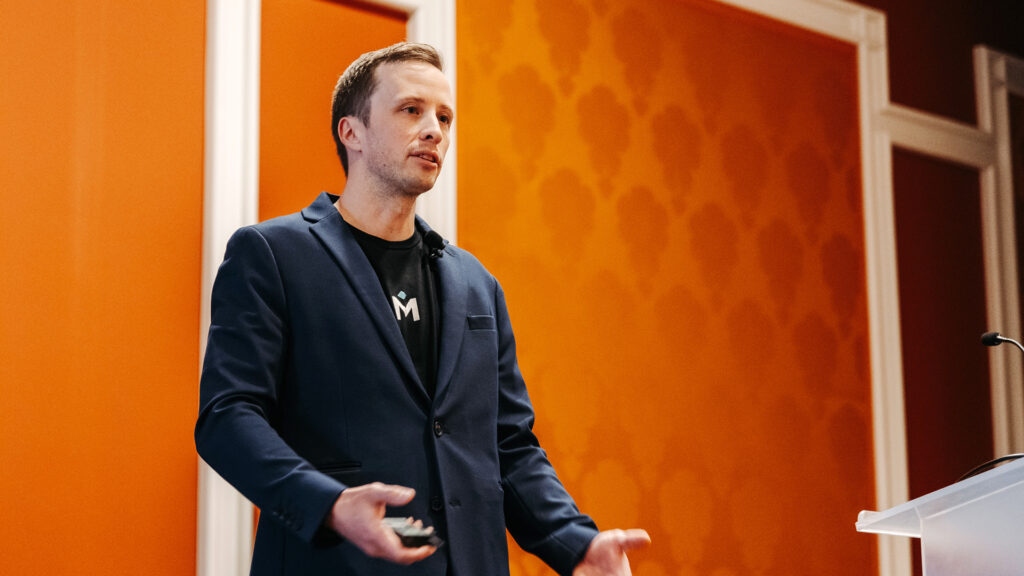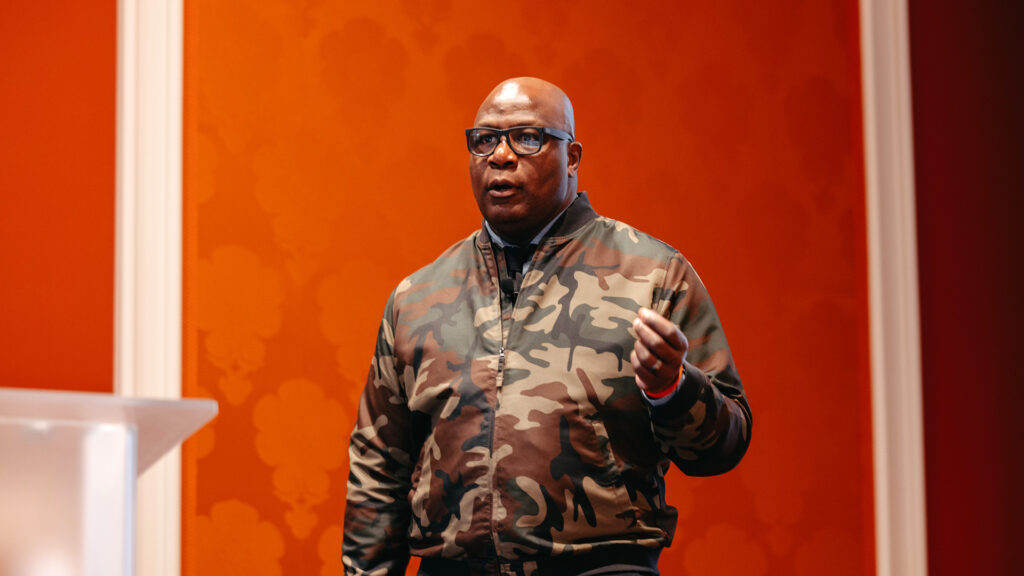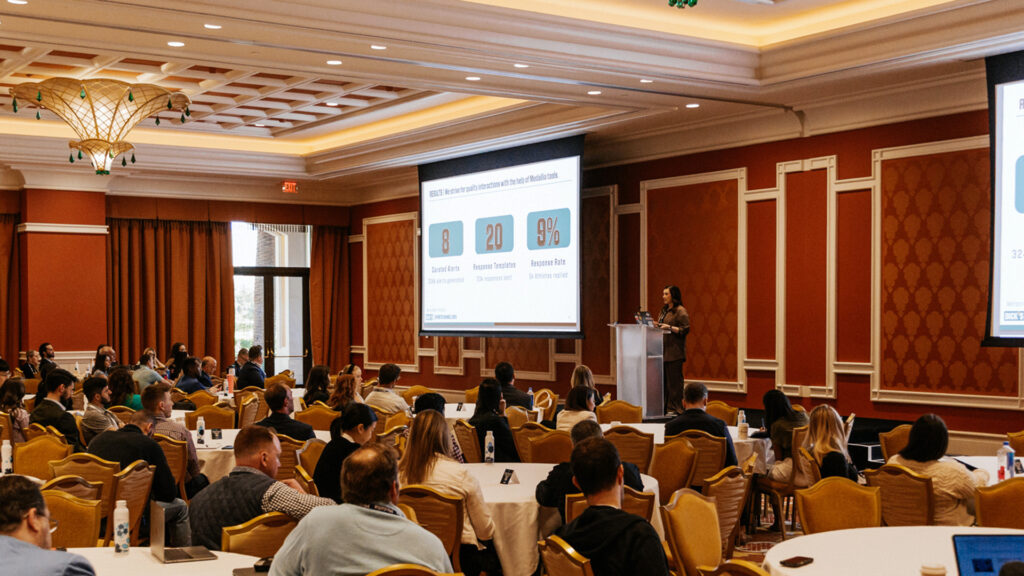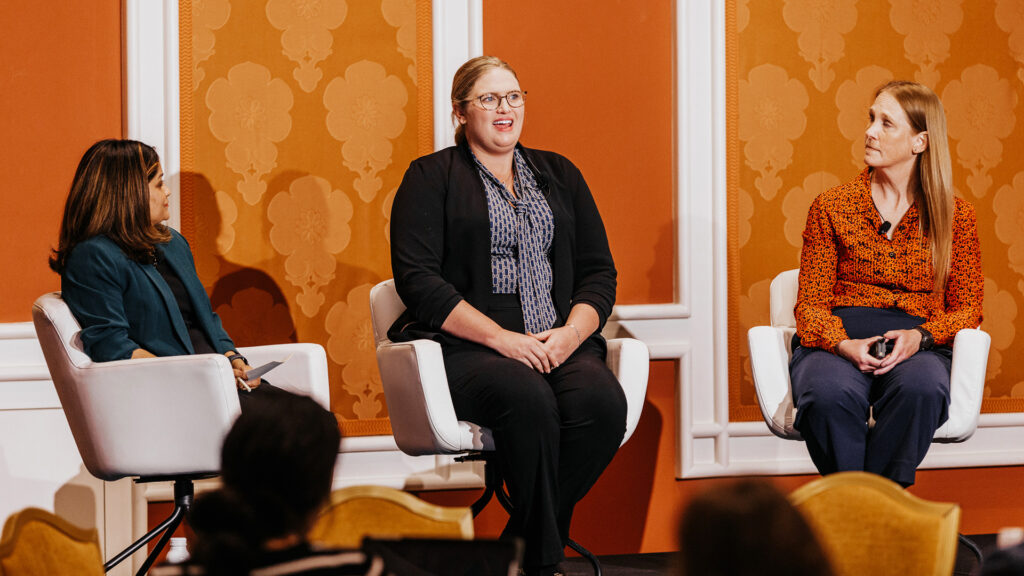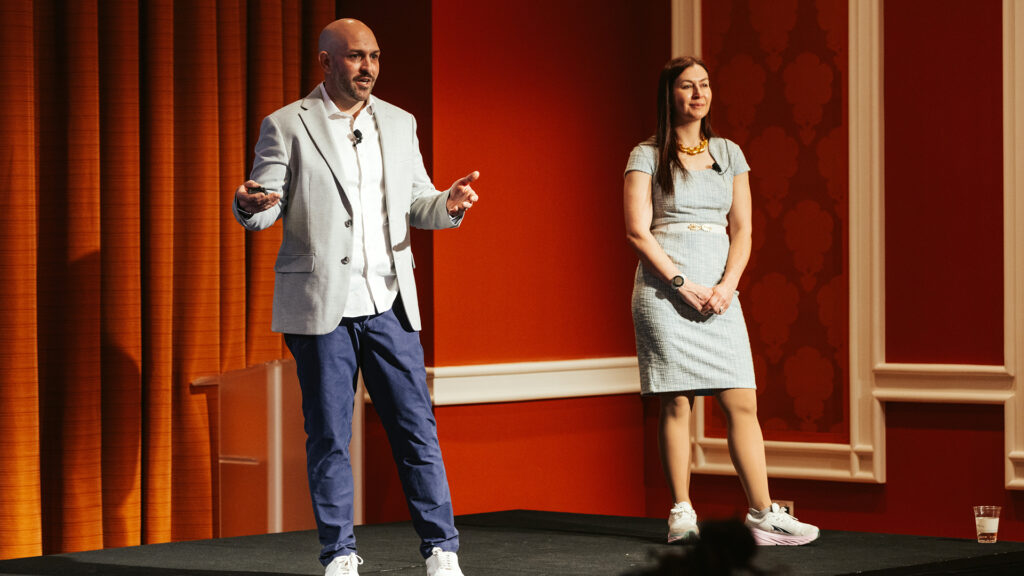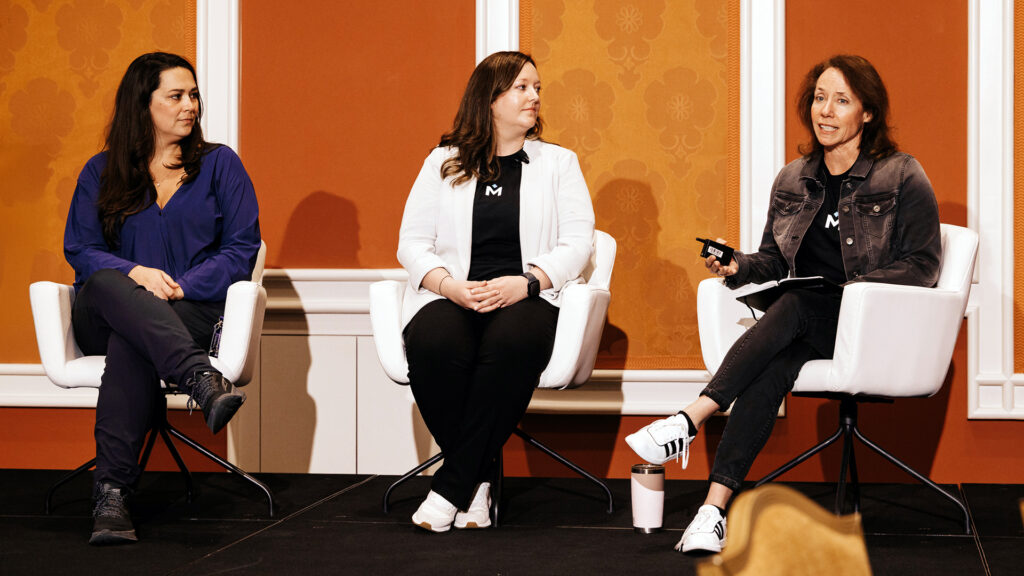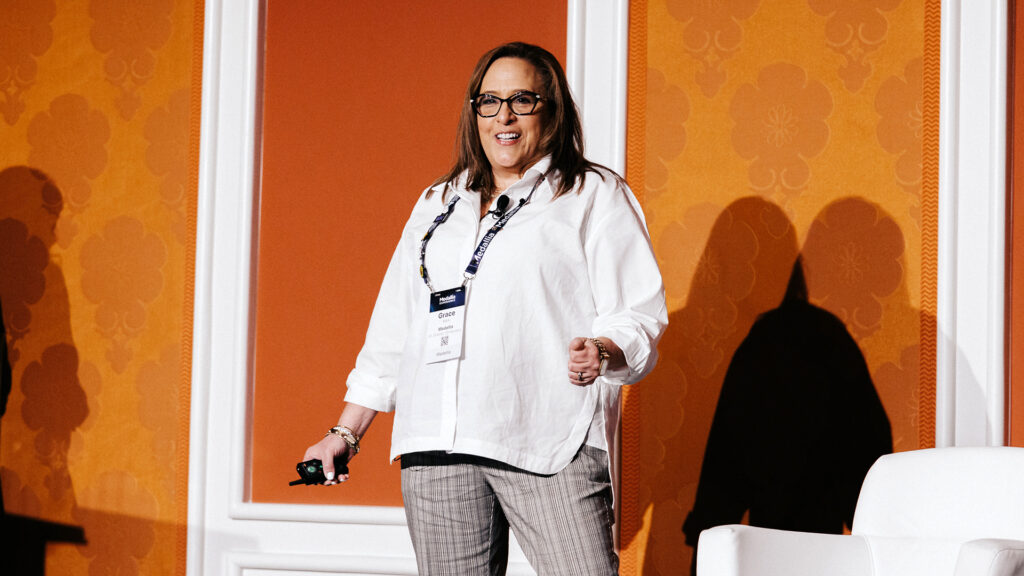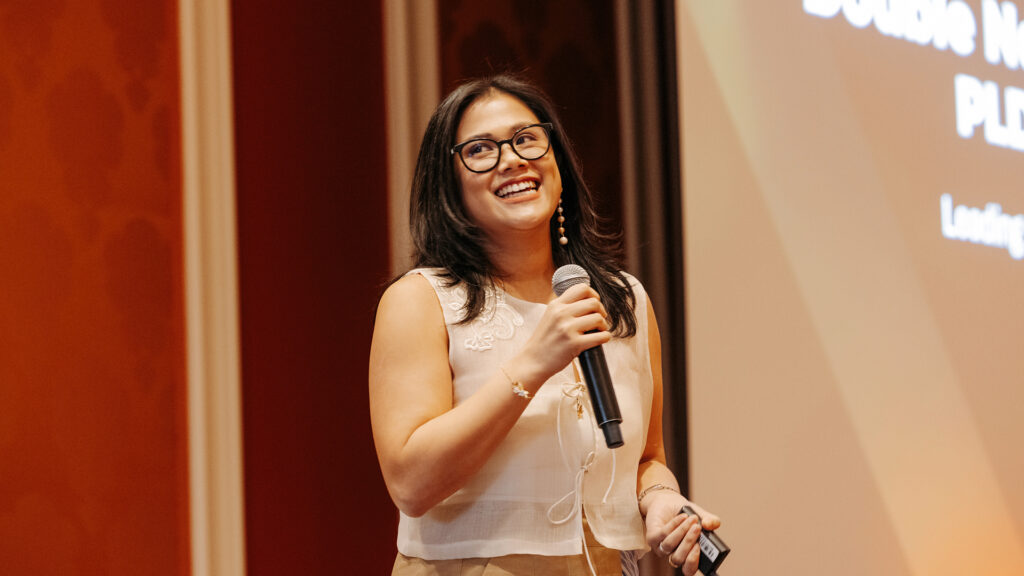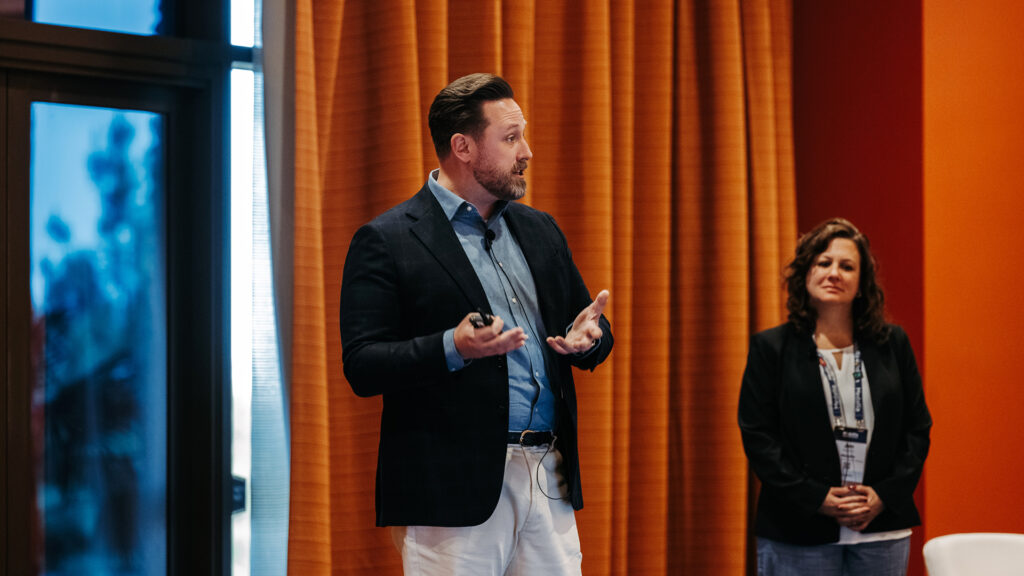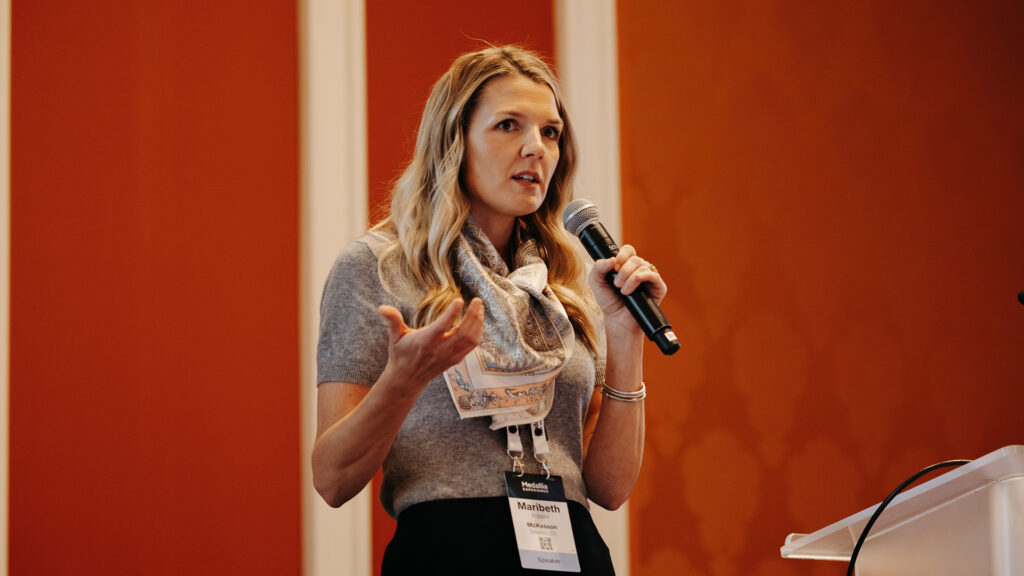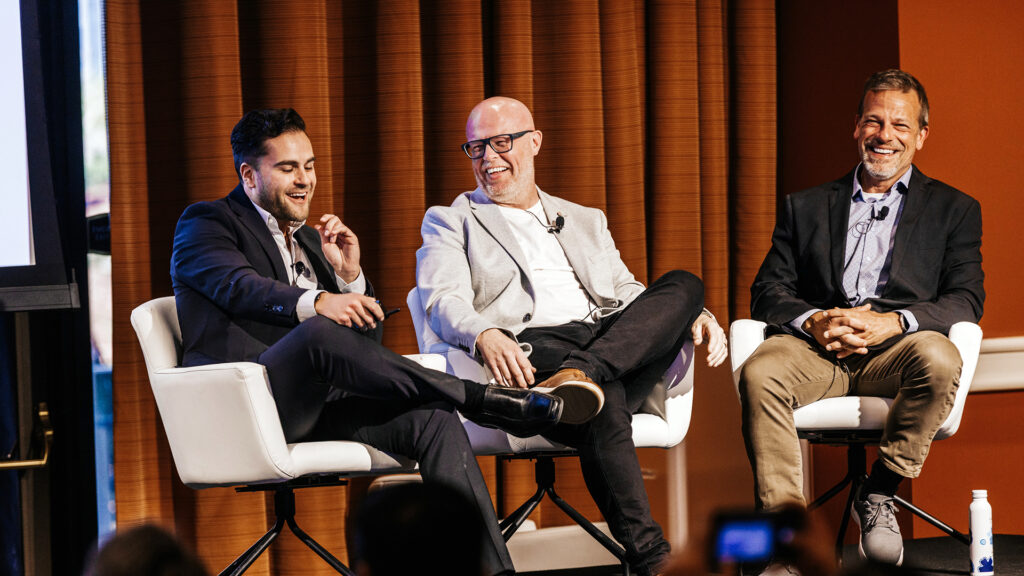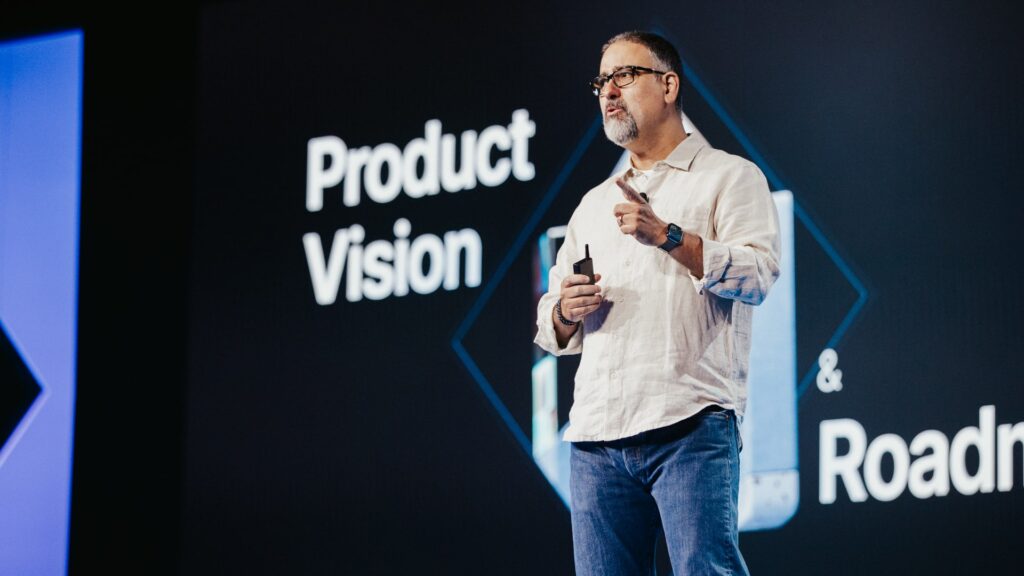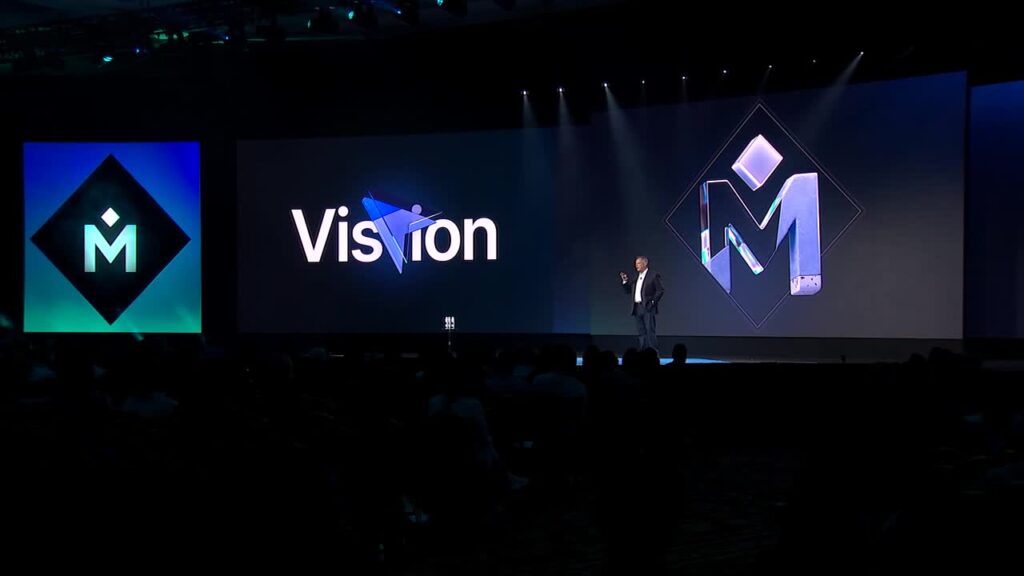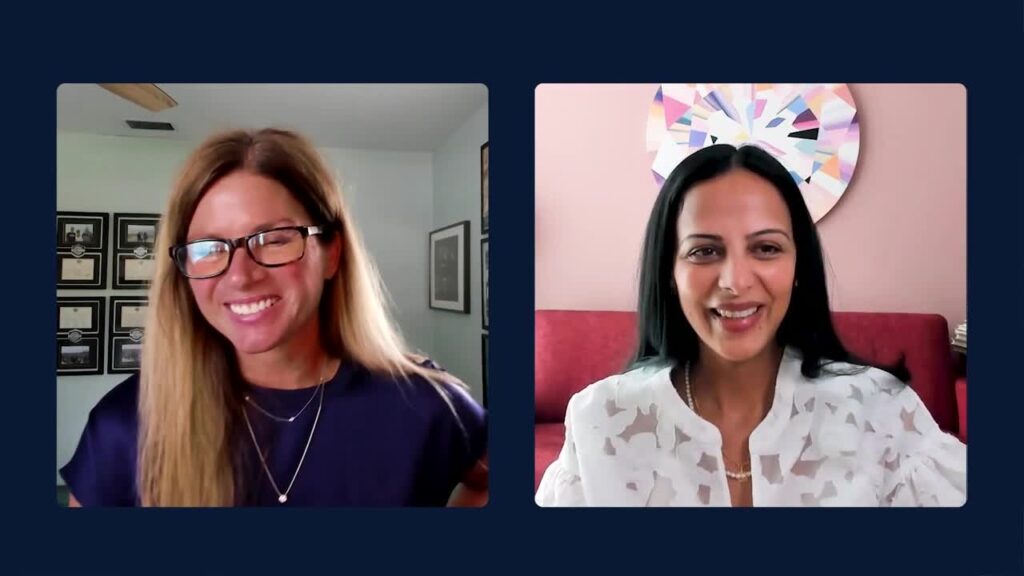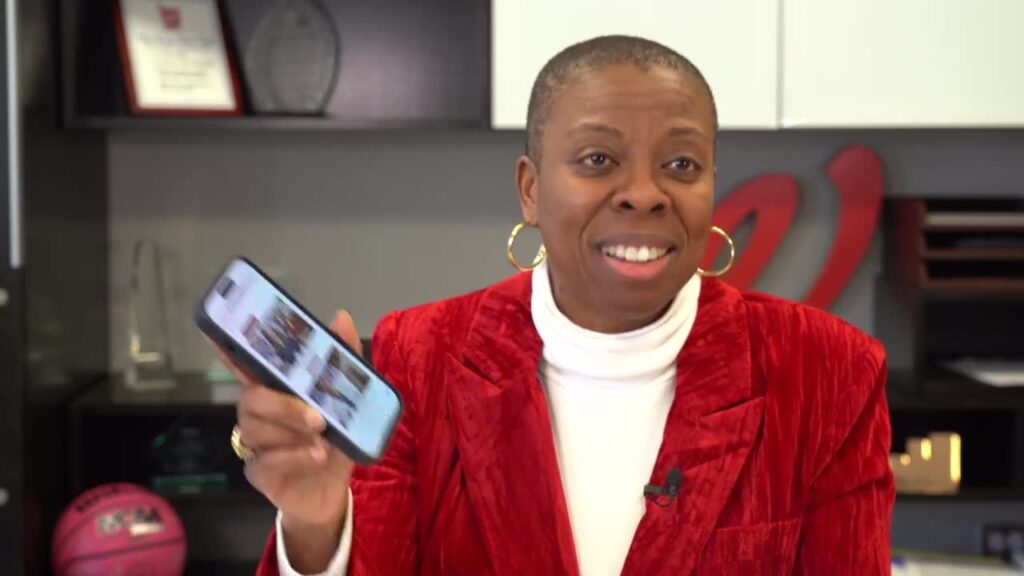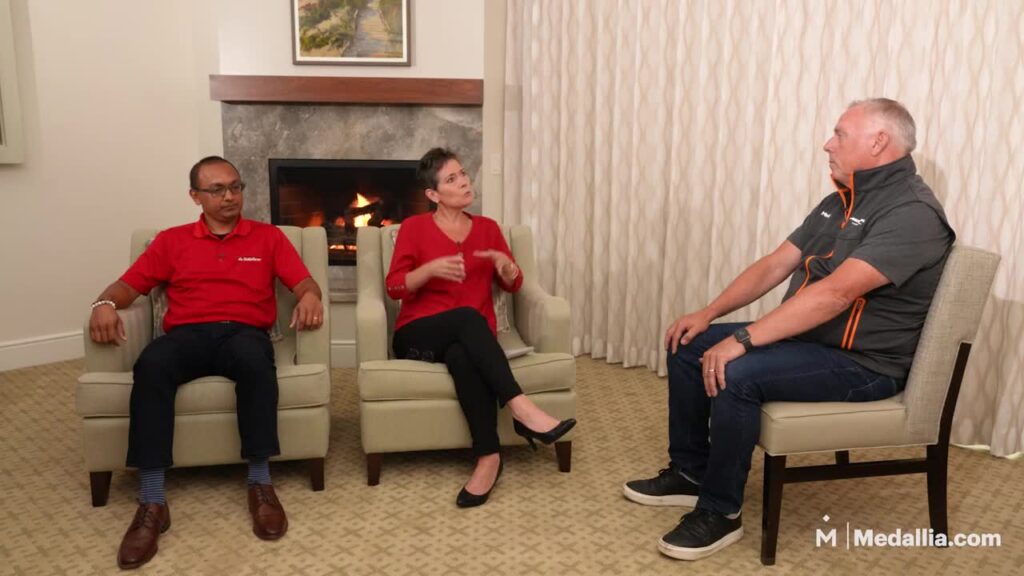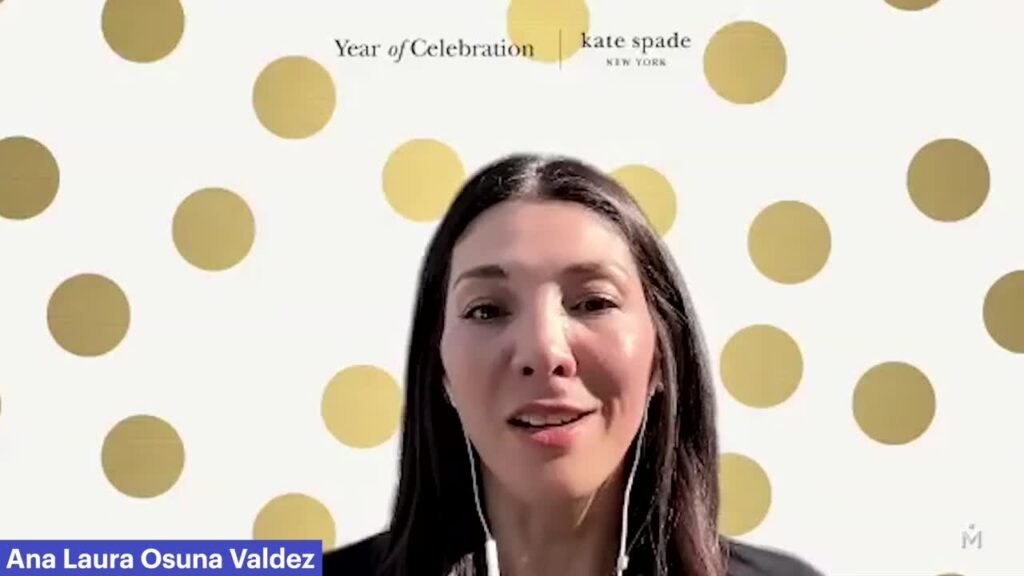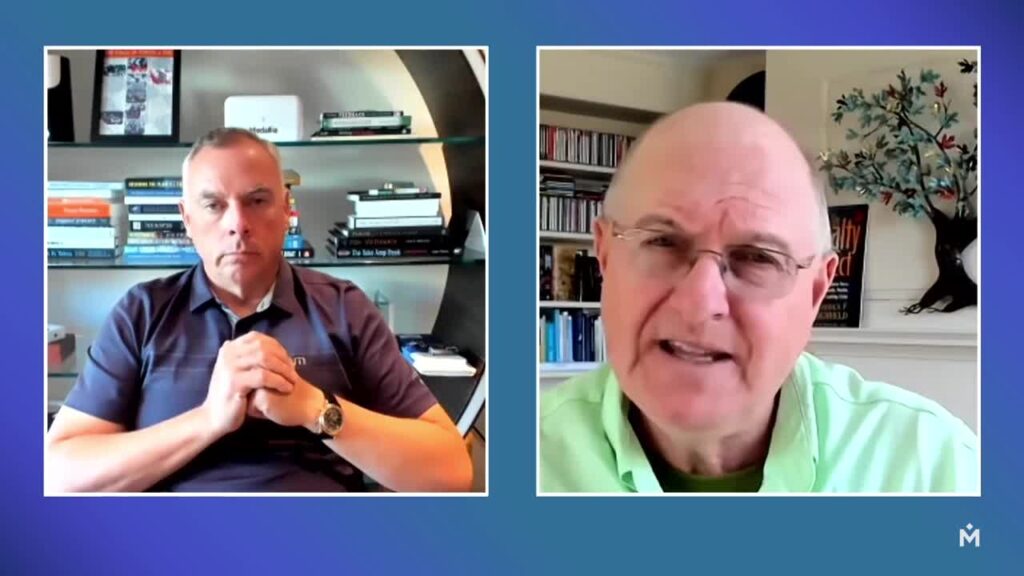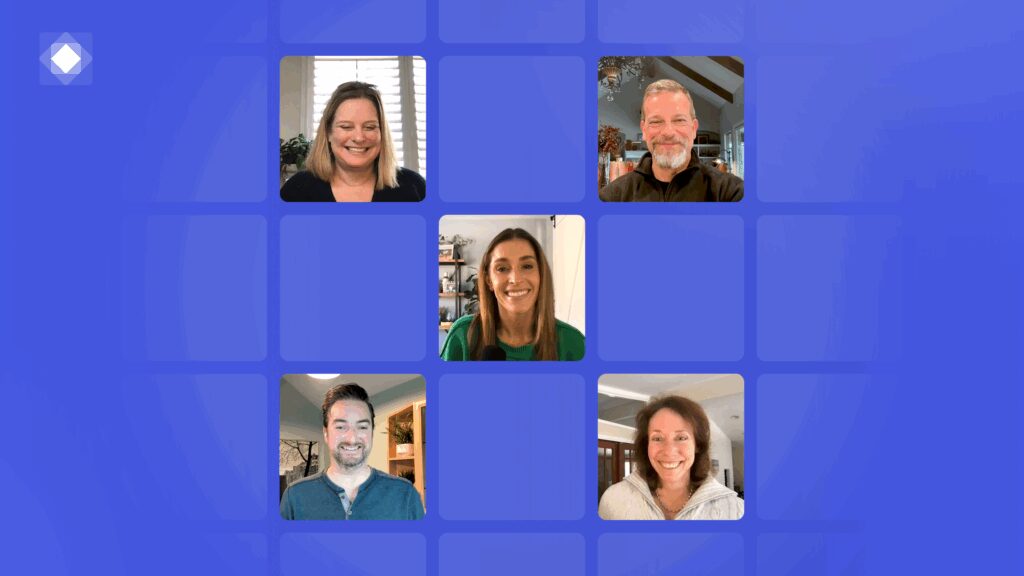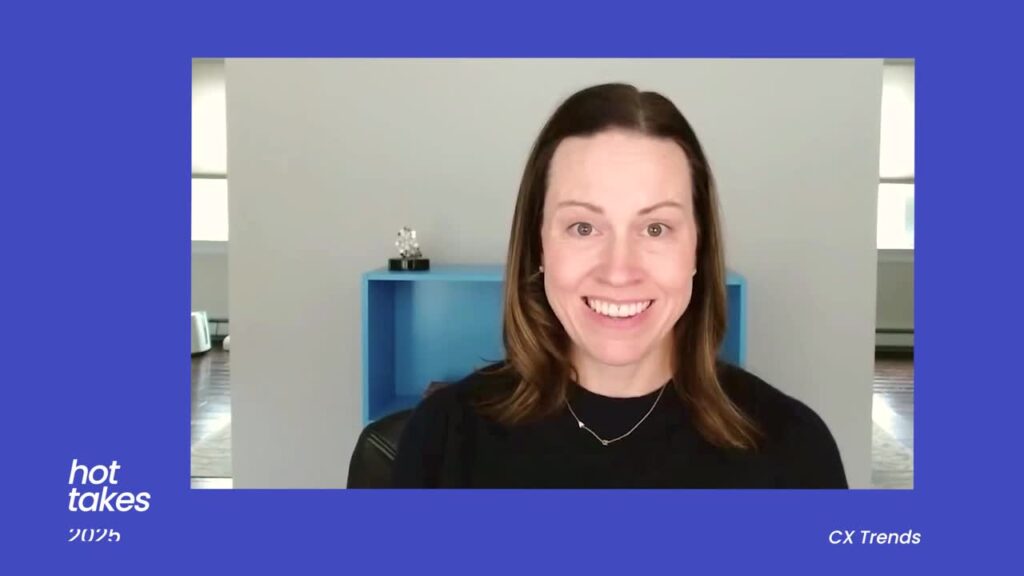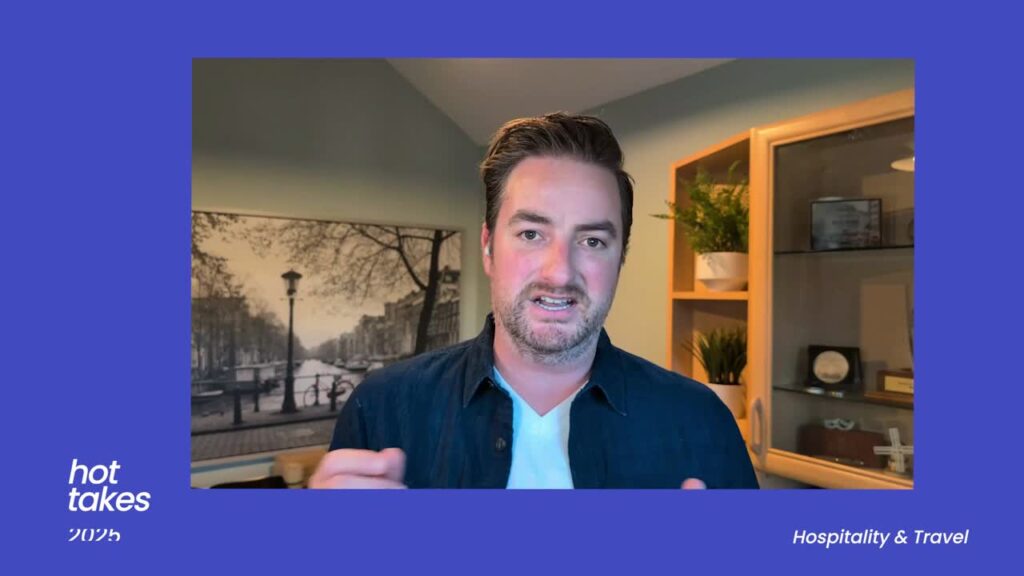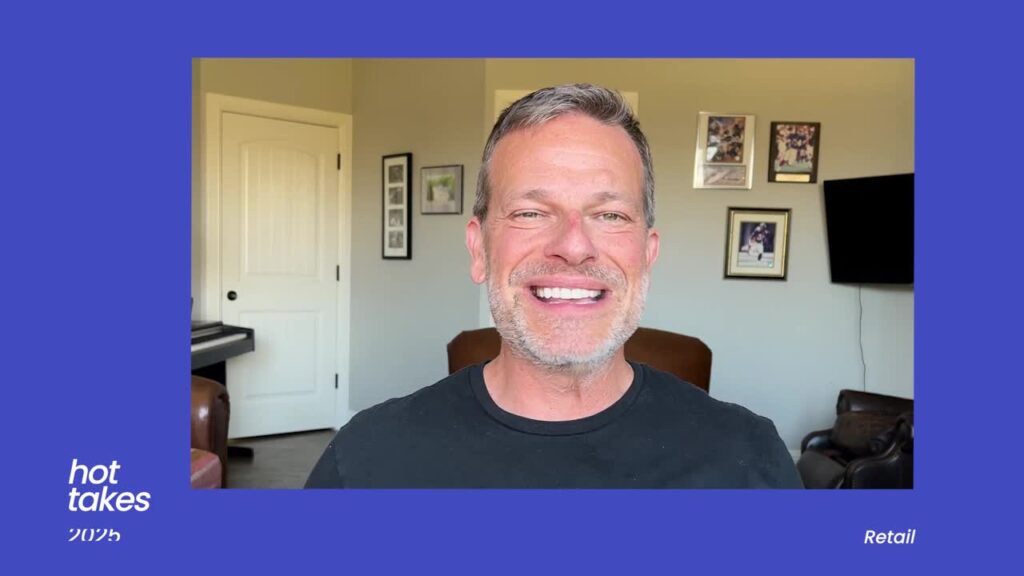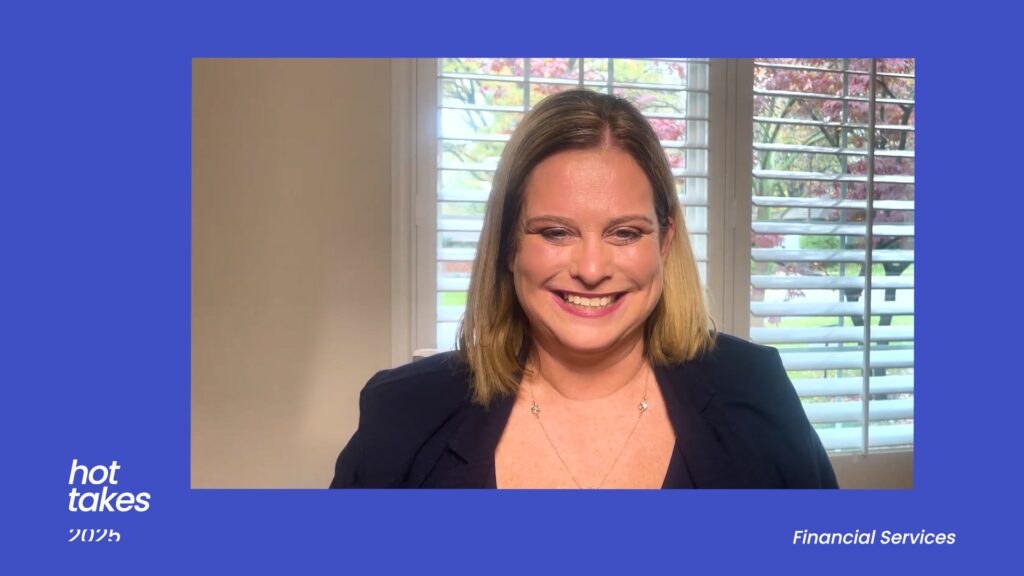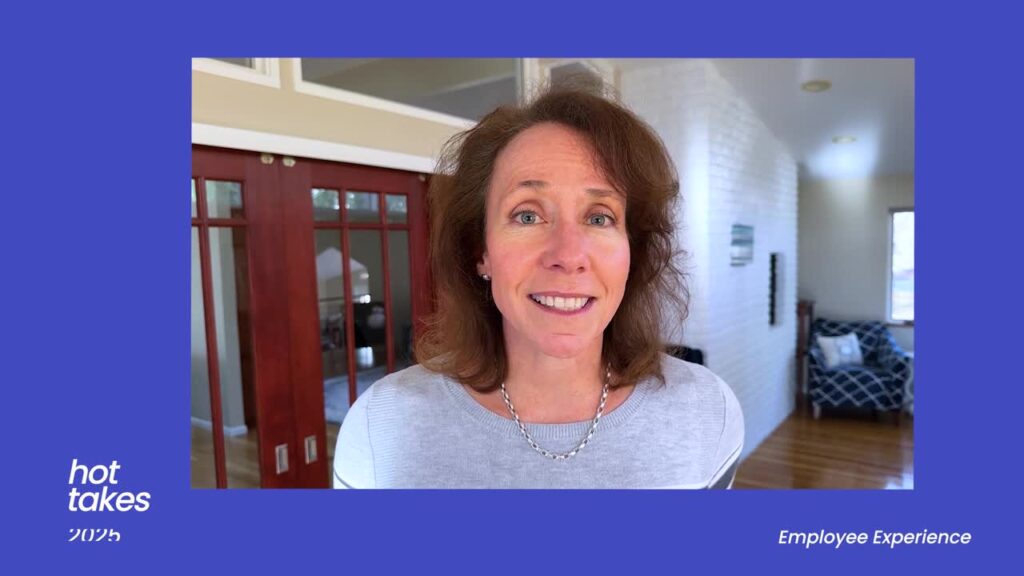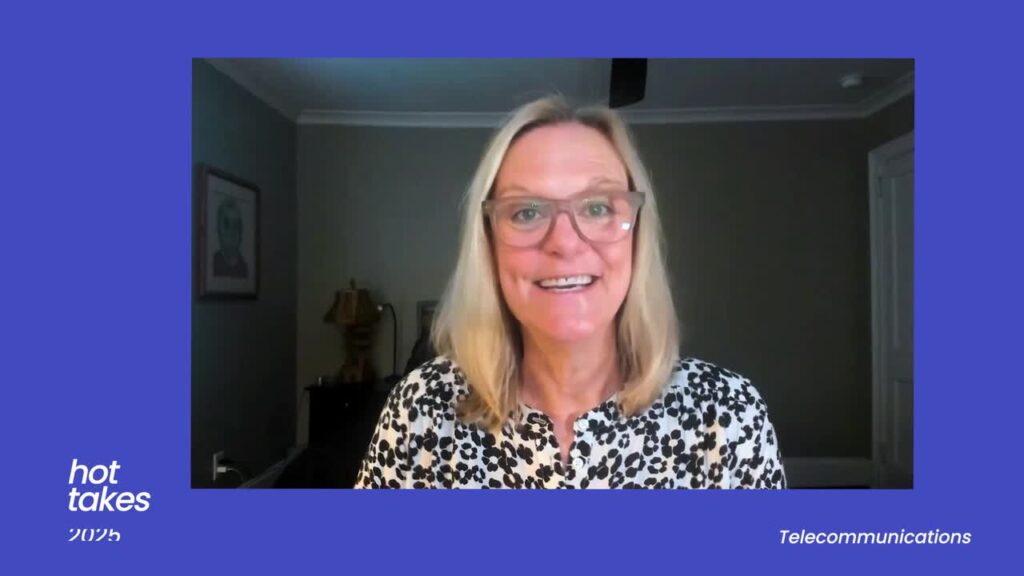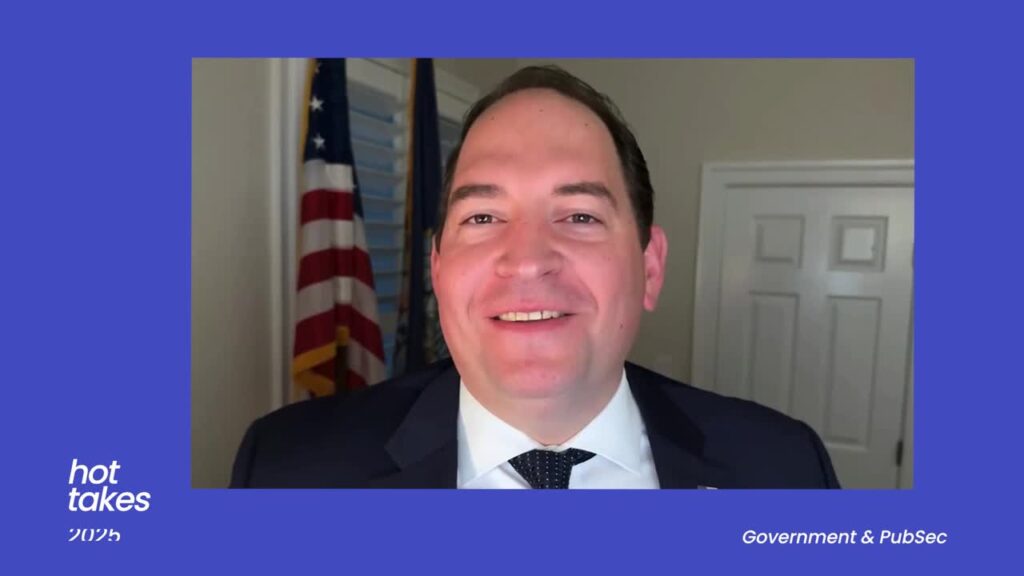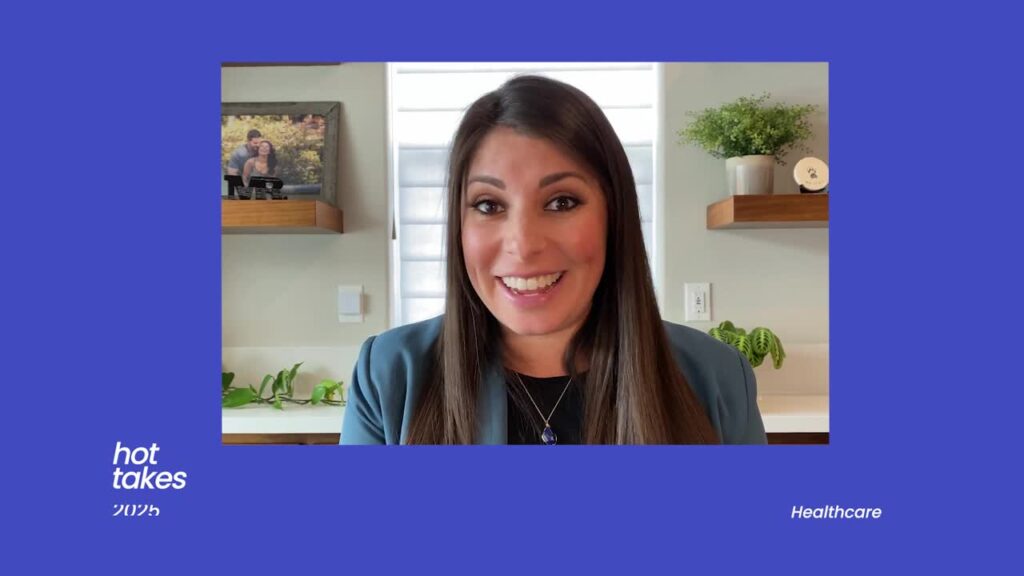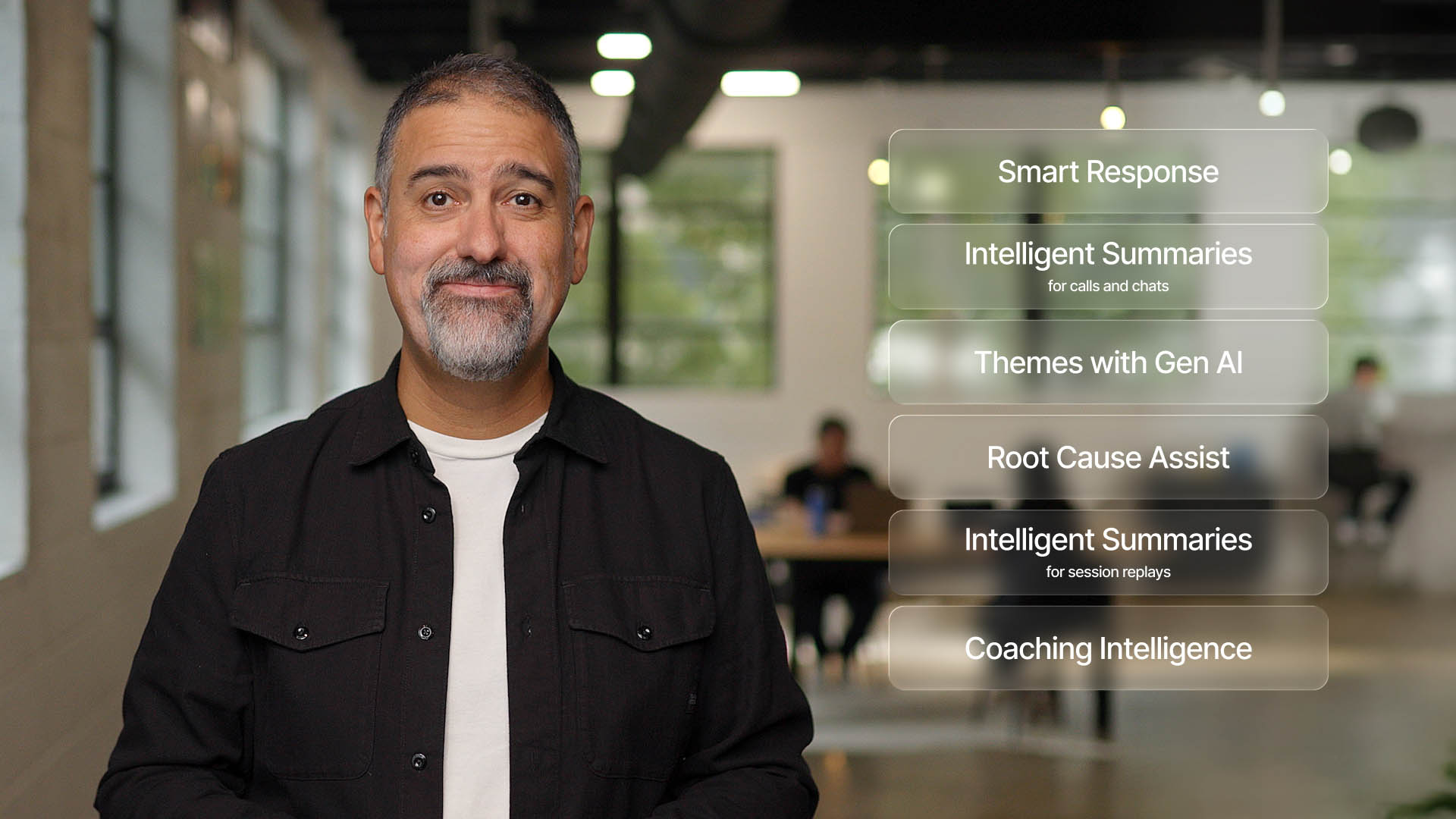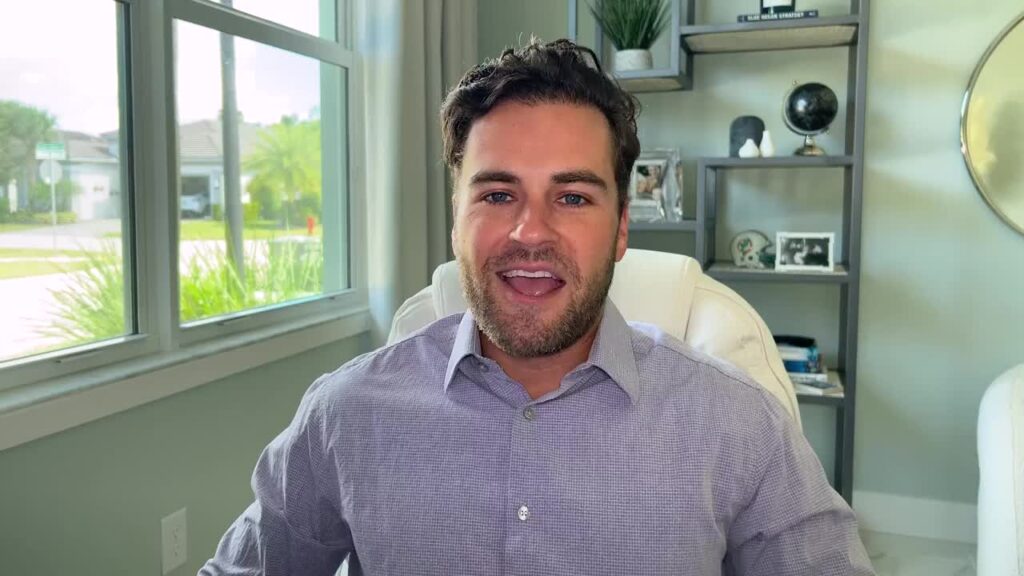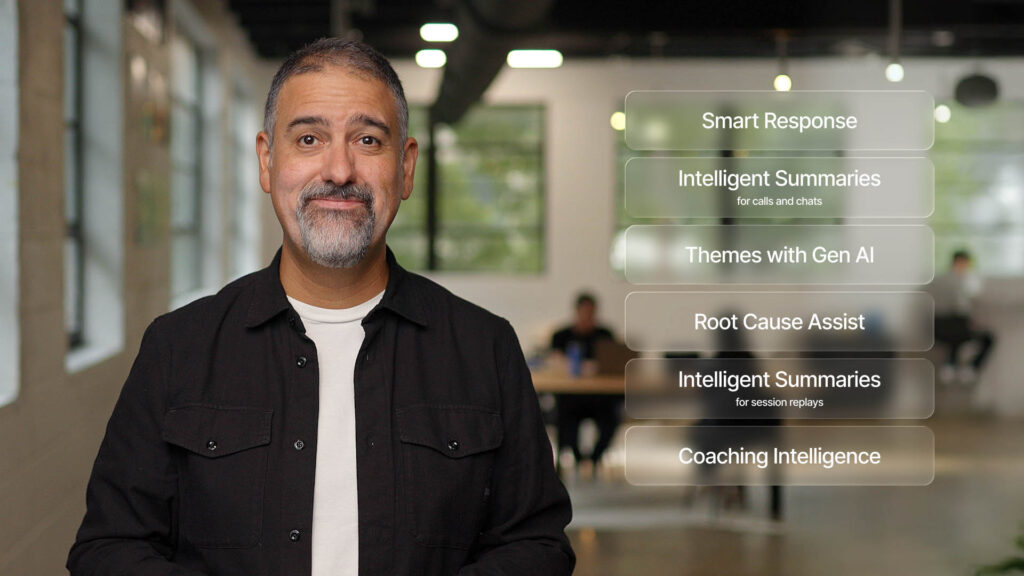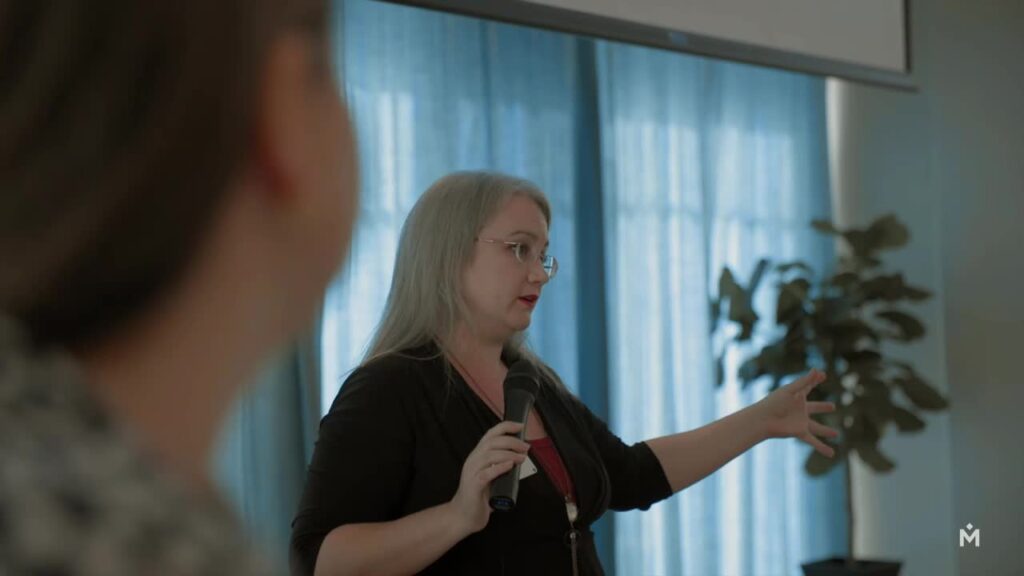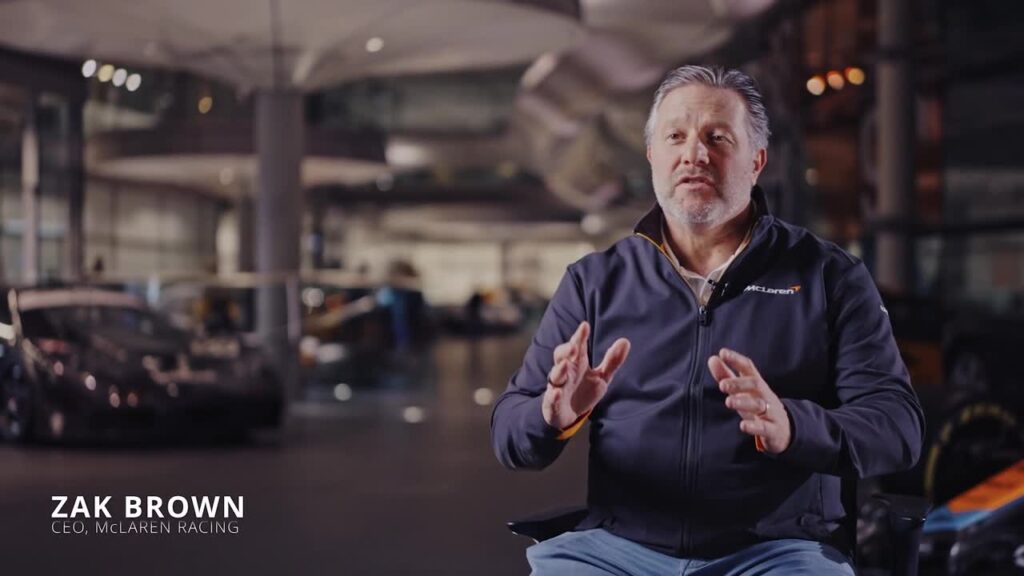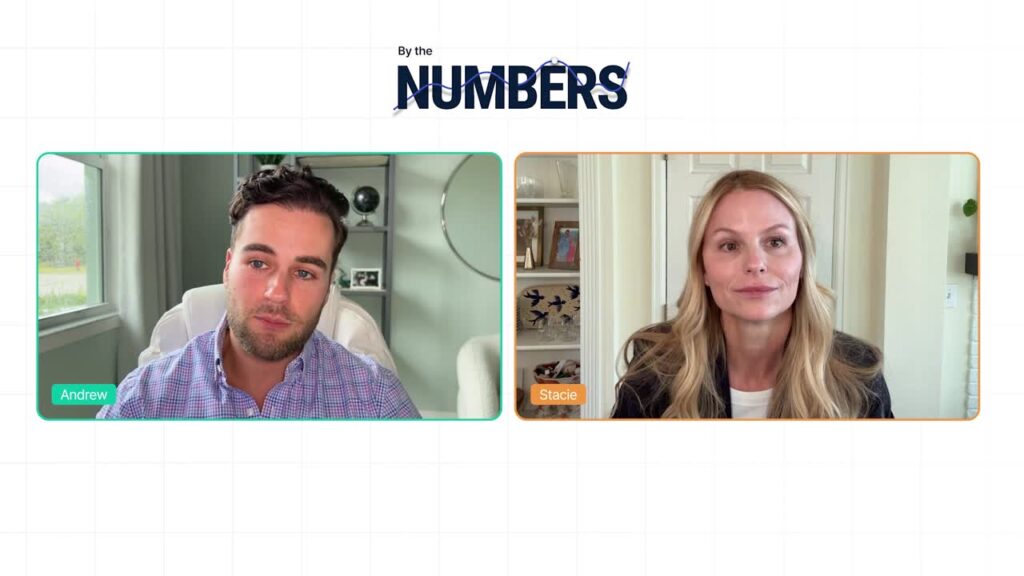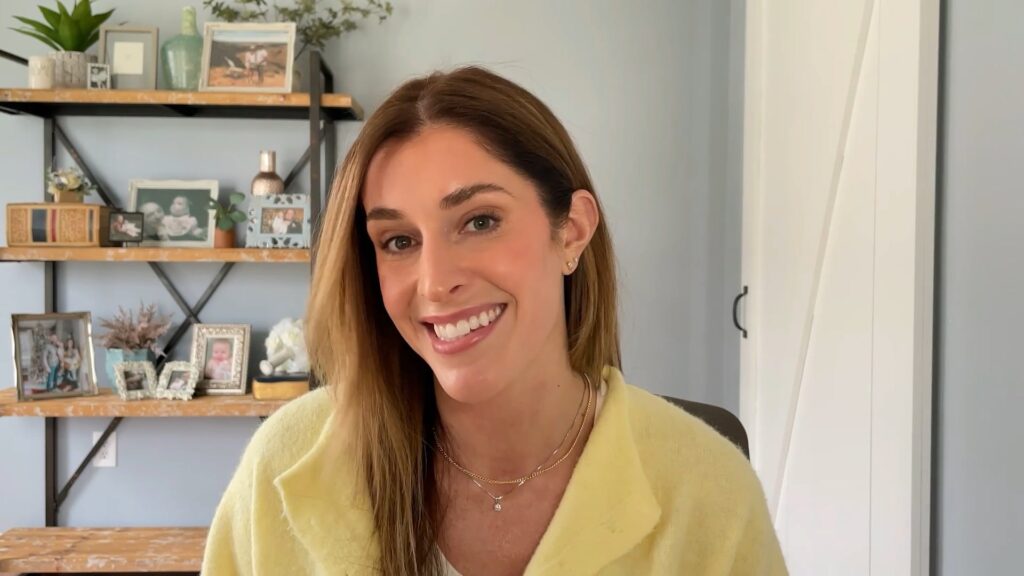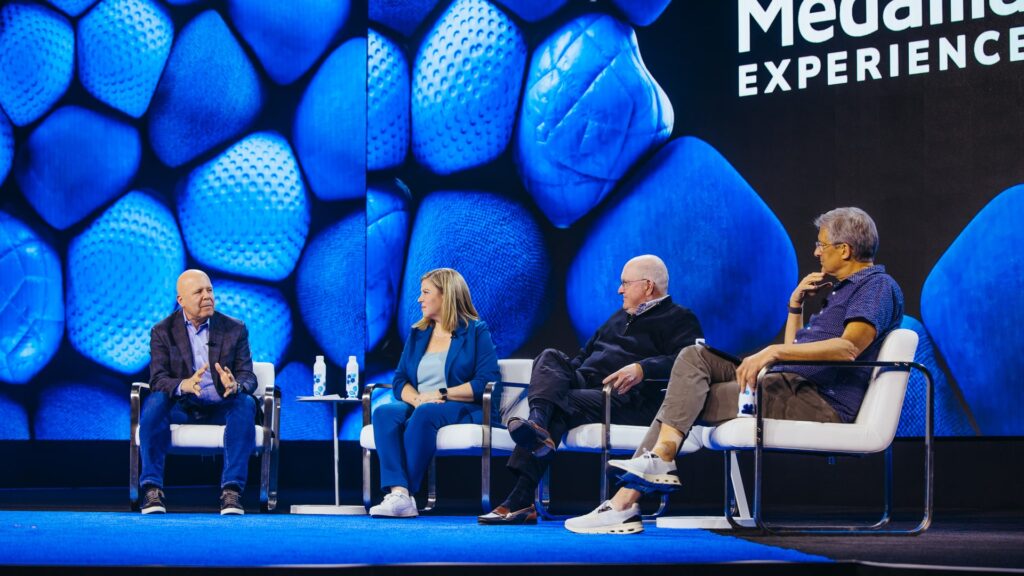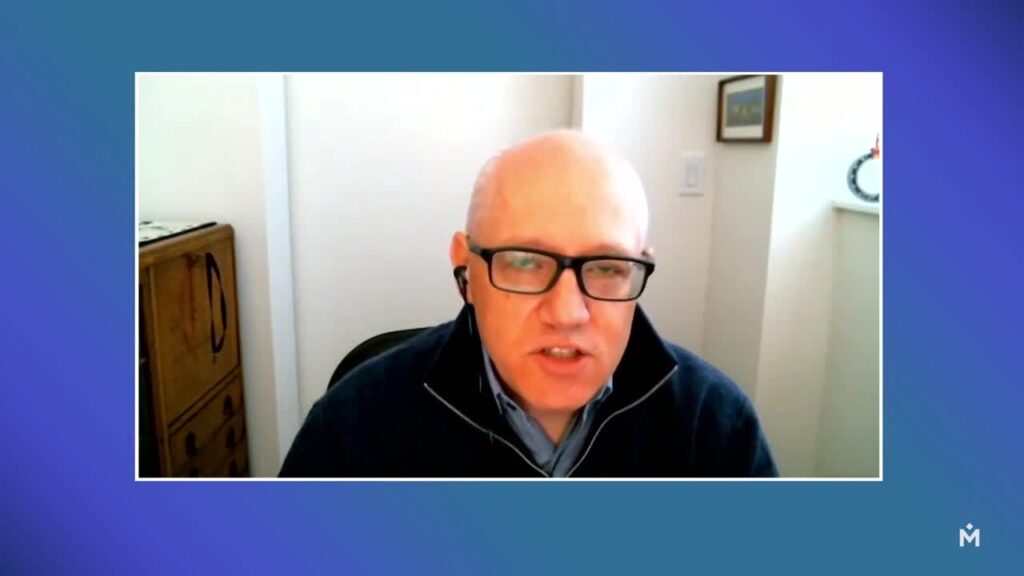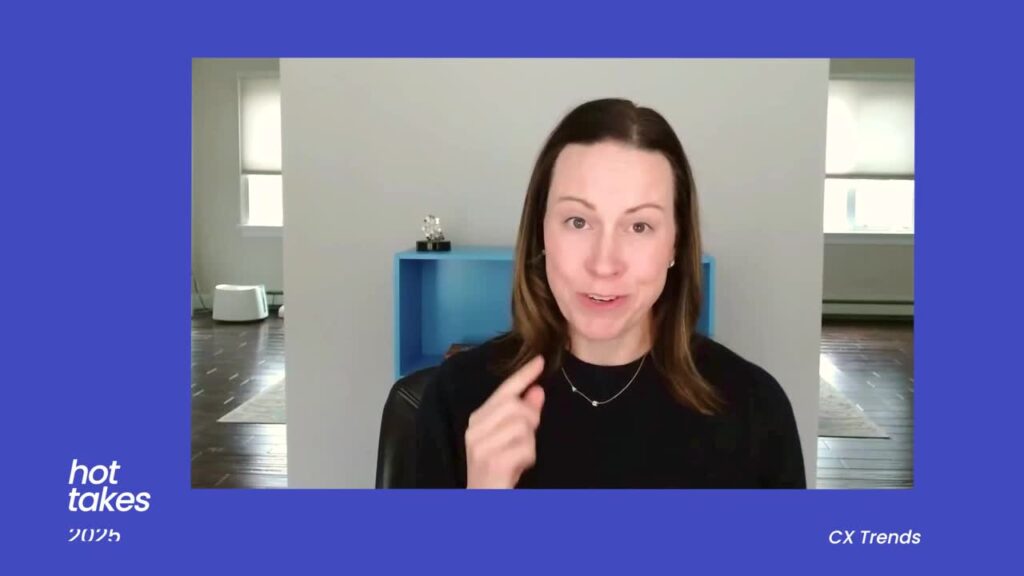Melissa Arronte: [00:00:00] Hello. Thank you for coming. I think we’ll go ahead and get started. It’s great to see so many ex fans in one room. My name’s Melissa Arronte. I lead the employee experience practice for Medallia, and I’ll let my co-presenters introduce themselves.
Courtney Jackson: Hi. I’m Courtney Jackson. I’m one of the senior employee experience advisors here at Medallia.
Part of my role is just working with clients as they’re going through implementation and beyond, and supporting them with strategic guidance on best practices as it relates to employee experience and culture, and tying that all together with your organizational strategy.
Lauren Jackman: Awesome. Hi everyone.
I’m Lauren Jackman. I am part of Medallia’s people and culture team, and I lead a small group called. Culture, experience, and learning. And I’ve been with the company for 11 years leading our voice of Medallia program. So that’s our employee experience program at Medallia.
Melissa Arronte: Yeah Lauren is customer number one, so everything we do, we try out on her first and ourselves, so it’s [00:01:00] well tested.
So what we thought we’ve talked to you about today aligning culture and brand, and we’re not gonna limit it just to, that we really expanded to everything ex cx because we really think that is the point of aligning culture and brand is to bring ex and CX together. So what we thought we would do is share with you some myths.
So the first one, culture is too soft or intangible.
Courtney Jackson: So I can take this one. And I will bust this myth. I actually hear this quite a bit from from leaders. And prior to working at Medallia, I actually was an ex practitioner. And I would hear that from the leaders that I was working with, that where they would say, why were you focusing on this kind of like soft and sunshine and rainbows culture?
And whenever I think about that, I also think about. Leaders having this perception that culture is just about making people happy. While we want people to be happy, it’s so much more than that. So whenever I’m working with my clients, I’m always asking them what is your brand strategy? [00:02:00] What is your organizational strategy and mission?
And then from there, what we want to do is build your culture in alignment with that strategy. So what are we committing to our customers every single day? And then how do we translate that into our people and making sure our people are inspired and really rallying around this kind of true north, this north star?
And that is the culture that we’re trying to build. It’s not just like pizza parties and free snacks and perks while I do love free snacks. That is great, but it’s so much more than that. It really, truly is a business strategy. Yeah, I
Lauren Jackman: could you imagine if it was only pizza parties that would a dream?
No. The only thing I’ll add to that, I completely agree with everything you said. It’s just that there are many ways to make culture quantifiable, right? And to show the impact that it can have. So in my team, we’re always looking at how to measure the impact of our culture initiatives and just to give.
One example, we have a [00:03:00] program, our Global Week of Giving every year, and we’ve studied that over the years. What’s different about people who engage in this culture program that we run And we can see that they score higher on all of our key employee drivers for EX and they also have 79% lower rates of attrition.
Melissa Arronte: So I’ll just add onto that we have a speaker tomorrow, keynote speaker, Denise Leon. So excited for you all to hear from her. And the focus of her recent work is a book called Fusion and it is all about culture and brand promise. And I think the critical thing there is what customers want from our companies is the same thing that our employees want from our companies.
They want. The brand promise, right? Our employees came to us because they believe in our promise, they believe in our products, and that’s what they wanna deliver. So that’s why this is so critical to both ex and cx.
Courtney Jackson: I had one more thought actually. As an organization, we say we wanna be innovative.
That’s our mission. That’s a really simple mission, but let’s say that is. Your mission as an organization, we’re gonna be innovative and impact the world. [00:04:00] Then the next question should be, okay, how are we recruiting people who are innovative? And what tone are we setting from the moment that we’re recruiting and onboarding and training our employees so that they are all really bought in and excited about this kind of innovative mission?
And then how are we building our environments to also make it a safe place for employees to feel comfortable to? Innovate and fail and, try new things and how are we reinforcing that message throughout the organization because every single thing that you do as a business is driven by your employees.
Yeah, it’s just bringing it all together.
Lauren Jackman: Great. Alright, so myth number two, ex and CX means a correlation between employee and customer survey scores.
Melissa Arronte: So this is my favorite one, and anyone who works with me regularly is probably sick of hearing about this. But the myth to me is that we’re focused on this correlation and so many companies [00:05:00] stop there.
They’re trying to get the correlation between typically an engagement score and the customer NPS or customer satisfaction. And there’s so many issues with the data in trying to do that, right? Often the engagement score is only collected once, twice, maybe four times a year. But the customer feedback or the customer NPS is coming in, right?
Every transaction, every time they interact with us and organization structure, I know no one wants to talk about it. It’s one of the strengths of Medallia, but being able to bring that data together with all of these issues makes it so hard. So we don’t have to start with the correlation. There’s decades of research that already established this correlation, so we can start with ways that’s much easier to bring the two together.
One simple thing that we could do is we can take a look, if we talk about omnichannel signals, we can to look at the calls that are coming to our contact center. So when a customer calls the contact center, and then we take that transcript, bring it into Medallia, run text analytics on it to understand it, and AI to summarize it, [00:06:00] we often think of that as cx, as customer feedback.
But there’s another person on that call, right? The employee and the things that the employee says gives us an understanding of how an ex problem is causing this customer problem that they’re calling in about or not being able to solve for. When that agent says, I’m so happy I was able to help you.
We’re not finding an ex problem, but when the agent is saying, I can’t help you, I can’t do this. This is out of policy, or my favorite coming from a bank. You’re gonna have to go into the branch to do that, right? Or they say no. These are all examples of employee experience issues that are causing customer experience issues.
So often a customer experience problem starts with an employee experience problem that the employee couldn’t overcome and becomes revealed to the customer. So if we look at the two together in some of these simple ways, it’s easy to see without having to worry about the difficulty of the data and the correlation.
Even if we got the [00:07:00] correlation, even if we did the hours of work to get that together and if it came out to be positive, it doesn’t always, we have some customers after all the work, it turned out to be negative, right? Meaning that the higher the employee engagement is actually the lower the customer experience score.
So that certainly wasn’t gonna inspire anyone to work on the two together. So even if we got the correlation, once we have that number, let’s say it’s 0.34. There’s some evidence that they’re correlated, but we still don’t know what to do, so we still have to do further work. So my recommendation is that we can start in easier places rather than starting with the correlation.
If it’s easy to do it, but if it’s not, there’s so many richer ways to get insights and ways to take action and bringing the two together. I
Courtney Jackson: completely agree with you. I think this came up in the last session as well. We were talking a lot about employee or linkage analysis offline. And while I do think that it is valuable I also think what does it leave you with?
What action are you going to take once you have that linkage analysis completed? We [00:08:00] have, like you said, to your point, we have decades and decades of research that shows that strong employee engagement is linked to strong customer or guest experience. We know this to be true. One of the things that I like to look at would be maybe using this kind of correlation or linkage analysis to reinforce the behaviors we’re looking for in our leaders.
One example of how that could look is if you know that when your leaders are holding regular one-on-ones with your employees or. Like a pre-shift meeting to set the shift up for success. That’s a behavior you want to reinforce because we know that leads to stronger guest experience, right?
Then when you can prove that out to your managers and you can show them the data is there, the linkage is there. This is why this is important. That’s one way that you can marry ex and CX to together in an actionable way by reinforcing, the behaviors that you wanna see in your managers.
Exactly. So
Melissa Arronte: employees should just do their job [00:09:00] and not worry about culture.
Courtney Jackson: This actually came up in the last session as well, so whoever had that question, if you’re still in here, thank you. Because I chuckled in the back thinking I’m going to be talking about that soon. So in some organizations that is the mindset, or in some countries where you work, that is the mindset that you know, employees are here to do their job.
Shouldn’t the paycheck be enough? And whenever I think about that, and I’ve actually heard that from leaders who say, employees don’t really care about the culture work that we’re doing. They just wanna come in, get the job done, make the sale, deliver the packages, whatever it is, and then go home.
And I would say that’s a bare minimum mindset. And is that really? What we are advertising for our customers, and is that really what we want out of our employees? And it’s so much more, as I already mentioned this already, but it’s so much more to make sure your employees are inspired to go above and beyond and innovate and come up with new ideas and [00:10:00] share suggestions to make your company even better.
We don’t wanna settle for the bare minimum, right? We don’t wanna just make employees. Happy at work. We want them to be really committed to us as an organization. So I would say that myth is definitely busted. And I would also add that employees want to do a good job for you. And whenever there are barriers that prevent them from doing their best work, that’s when we hear frustrations, they wanna solve those problems so that they can create a great customer experience.
Lauren Jackman: Yeah. So what I’d add to that is just that. The myth itself is belying a misunderstanding in my opinion, about what culture is. So culture is about how people do their jobs. So if people are just showing up, and to your point, doing the bare minimum that says something about your organizational culture, right?
And it may not be as healthy or as strong as it could be. A defining feature of any organizational culture is gonna be about the nature of the interactions people have. So when you’re [00:11:00] talking with your colleagues, are your interactions characterized by vulnerability based trust? Can you ask each other for help?
Do you feel safe to share a new idea? Can you admit when a mistake is made or is it like the blame game? Those are real things that impact how people can do their jobs, and they’re gonna be dramatically influenced by the kind of culture that you have as an organization.
Melissa Arronte: Yeah, and back to talking about the bare minimum, employees don’t wanna do that either.
Employees come to work because it’s something where they are gonna have an impact on the lives of their customers, whether internal or external. They come to work because it gives them a purpose, right? We only have a few purposes in life. Often it’s about being a parent or a spouse, and. What we do for work a life with purpose is a life with meaning, and they came here to deliver on that promise to the customers, and that is culture.
How we deliver, how we think about that brand promise and what our brand means and how we deliver that. Number four cultures, hrs [00:12:00] job, and not mine.
Lauren Jackman: Okay, i’m answering this question, right? You all know the name of my team is Culture, experience and Learning. So I truly do believe, like if something is everyone’s responsibility, it can too easily become no one’s responsibility.
So in my opinion, this is it’s a both and yes, you should have some people with an explicit responsibility for promoting organizational culture. That being said. 100%. You need to have culture champions across your organization, every region, every team, across levels. And if you don’t have that, what you may have is a big discrepancy between what people in culture or HR is saying.
The culture is right, what they want it to be, and what the real culture of your organization actually is. And that’s a problematic environment to have because it breeds cynicism and skepticism and sometimes resentment, right? We all know like when it’s like the eye roll of oh yeah, this is what our culture [00:13:00] is.
No, you have to mean it and you have to have people bought in across the organization.
Courtney Jackson: I also think whenever, i’m talking to my clients and I work with a lot of organizations where the employee feedback is sitting within the HR team specifically. And then we’re always having these conversations of how do we encourage our employees to take ownership of their own experience or be empowered to take ownership of their own experience at work so that it is not just.
As an employee, I’m sitting around waiting for HR to have this life changing impact on my experience at work and our culture. It really is owned by all of us and our shared commitment to the success of the business and it’s, I keep coming back to this, like how do we. Inspire our employees to rally around this shared purpose.
And that takes everyone, not just hr, while HR is very knowledgeable and impactful in that space, and we’re very grateful for them. But it is a shared responsibility and we can all be [00:14:00] very proud of that. And usually whenever we give employees that empowerment, they do take a lot of pride in okay, I shared this idea, I’m having a positive impact.
At my company I can really be connected to the purpose of the company and the work that I’m doing. Myth number five. Omnichannel signals are only for
Melissa Arronte: cx. So you all probably heard this morning in the keynote, our focus on signals and a survey is one form of signal, but there’s so many different channels that signals can come into us.
And one thing I’ll say for anyone who’s here, who’s in HR and has not seen customer feedback or customer signal data, I hope you’ll go ask your CX team to share it with you because it is filled with feedback about employee experience, not just about employees, where they talk about the service provided by an employee, but the actual experience that an employee is having when the customer has to wait, when the information is wrong, right?
When they’re stuck in long lines. Digital friction. I think that’s such a great example of a severe [00:15:00] customer problem that we all experience, and I have such a terrible story to tell you in a minute on my trip over here. But it’s such a great place to find employee experience information. So when a customer experiences digital friction hard to get onto the site, get things done, get their tests accomplished to move on with their lives, employees created that process.
And they didn’t intentionally create it with friction, but what the employees are dealing with, right? Typically in financial services, any of you in financial services, we have new systems and we have legacy systems, and we make our employees work across both of them and figure out how to deliver for the customer when one is still with that flashing dos prompt.
You remember that? Anyone who’s old enough to still remember that and my bank, we did make our contacts and our employees still use a system like that while they were also using incredibly brand new. Systems like you would see almost an apple-like experience. So the types of tools that we give them, the restrictions we put on them, the regulations, [00:16:00] the attempt at controlling risk, all of those are ex problems causing that customer digital friction.
So much insight we can get when we hear from the customers in a digital survey or the type of experience that we’re seeing they’re having. And then I would say to anyone who’s in CX. Go to your HR team and share some of the feedback you’re getting from customers. Chances are your HR team has never seen it before and it’s so eyeopening to see what our customers are saying about our company, about our employee experience, and then of course what they say about our employees.
But often that’s the good stuff, what they say about our employees. I, so my story, I flew an airline that I’m not gonna tell you the name of, but some of you may guess. And as I’m going in the Uber, what I find is I don’t have the TSA pre-check, but I have TSA pre-check, but it’s not on there just for this airline.
Every other airline, I fly, it’s fine and it’s there. So I try going on the app because I know I need to fix something. It happened last time I flew with them. My name on their [00:17:00] app is Melissa Eileen, but the name on my driver’s license is Melissa e. Now, I think we could apply common sense and realize I’m still the same person, but according to this airline, I am not the same person and I cannot change it on the app.
If I wanted to change the E to Eileen, I can do that self-serve on the app, but I can’t change Eileen to the E on the app. So someone figured out there is a problem here, but they haven’t resolved it. So then I try a chat. I then go online. I call the contact center. We still don’t have this solved, and finally in person, they’re able to solve it for my one flight here, but my return flight, I have to do it again, and my future flights are already scheduled.
I have to do it like incredible digital friction and the employee experience for all this, all these employees I interacted with, they all felt terrible that they couldn’t help me with something that’s so simple and it’s so common sense. It’s embarrassing, right? This is a customer problem. It’s an employee experience problem because they don’t have the ability to rectify this, and it was [00:18:00] created by an employee, someone who is probably trying to make this the most secure site we could have.
But at the same time, they can’t recognize the e and Eileen is actually the same person I.
Lauren Jackman: Yeah, I’ll just add to that, I think you’ve pointed out a lot of great ways that CX data can help inform ex. I think there’s also lots of different kinds of signals that you could pull in that are about the employee experience, right?
Like maybe you used an internal tool like ServiceNow and you have ticketing information, right? Who’s submitting tickets, who’s closing tickets? Maybe you’ve done an organizational network analysis and you know about who’s a hub that’s connected to lots of different people and how does sentiment spread across the organization.
So I think there’s, to me, this is like a really exciting future direction for EX is just starting to connect the dots on all the different kinds of data that’s out there.
Melissa Arronte: I agree, and we do have a document. We spent a lot of time working on all the different kinds of signals that could come in and classifications of signals.
If anyone’s interested, please reach out to one of us. We’re glad to share it with you and love to hear about signals you’ve [00:19:00] thought of that maybe we haven’t.
Lauren Jackman: Okay. Myth number six. Employee surveys should only be conducted by hr.
Melissa Arronte: I do love this one. Sometimes on some days at work, I talk to CX people more than I talk to ex people, and my primary role at Medallia is ex, but I think it’s quickly becoming ex cx.
That is my passion, and I have worked in both. So what they’re asking me is who should be conducting employee surveys? And the first thing people tend to think of is the engagement survey. And of course we have to leave that in hr. There’s confidentiality and all the other things that go along with it, and the importance of that survey to our C-suite and the board and all of those things.
So that should stay where it is. But there’s so many other kinds of surveys we can be doing of our employees when we talk about the friction that our customers and employees are experiencing. We could ask our employees about this. If we think about employee experience in all the ways that we interact with our employees and how they work, and that their goal in coming to work for us is to have a purpose and to deliver on it, to do [00:20:00] something that has meaning, right?
This is exactly up the line of what employee experience is. That probably isn’t handled by hr. We can ask them about where they’re encountering obstacles. In doing their day-to-day work and their suggestions for solving for them. ’cause when you ask an employee for a solution, it’s not like asking an executive.
The executive often thinks of a $3 million tool that needs to be implemented, an incredible cost of labor of doing that. But when you ask an employee, their solutions usually cost nothing because they’re figuring out really creative ways to get things done for their customers and to make their work more efficient.
These are great places for people outside of EX or hr, being able to survey employees. Now, we expect employees in these surveys to be talking about systems, processes, policies, guidelines, all those things, and getting their work done. But just like customers, an employee could say anything when we ask them, right?
And give them a survey so we can put alerts on that data. If HR is concerned [00:21:00] that an employee might say something about harassment or ethical issues, or other things, that should immediately go to employee relations or legal, as with an alert that can be triggered in real time through Medallia, right to their desk, so the right people can take care of it immediately.
We can also trigger it to all those people that can be solving the problems across the organization. For these employees, it finance, of course, hr. Operations, sales, procurement facilities, such a big one, but so many opportunities
Courtney Jackson: there. Yeah. There are so many functions within an organization that have a direct impact on your employees and their ability to do their jobs.
And sometimes, de depending on your organization, some decisions are made at a higher level that directly impact the frontline and those teams. Let’s say you’re rolling out a new app, or I always think of. My husband works for a delivery company and so he works with a, it’s called a dyad, and he has to scan his packages when he is delivering them.
And anytime there’s a [00:22:00] new update to that tool, I always hear about it. And as usually they made this update and they have no idea what we actually do every single day. It is added three steps to my process, and I’m always like, okay, that needs to be bubbled up to somebody not in hr, but whoever.
Owns this tool or this system. I’m sure they would love to hear that feedback because I’m sure they could very quickly revert back, make a change and make that process easier because nobody’s wanting to add steps to an employee process. So whenever we’re thinking about employee listening, and we are talking a lot lately about activation and kind of.
Giving employees the opportunity to bubble up that feedback to the teams that can impact the change quickly and efficiently. That doesn’t have to live within hr. Now I’m sure HR would like to be consulted on that. I think we had that conversation of, there needs to be some visibility and oversight and like [00:23:00] partnership and trust that is, is definitely there.
That is helpful and some guidance. From the HR team because the HR team and communications team usually has really great insight on the best channels that are most appropriate to reach the employees at every level throughout the organization. But it doesn’t have to be completely owned by hr, but just more of a partnership.
Lauren Jackman: Yeah, I completely agree. We’re talking about employee activation, the concept, the role of the subject matter experts, and getting the feedback and taking action and closing the loop. It’s critical. So it can’t all sit in HR ’cause we don’t own everything. We need to get it to the people in the organization who can do something differently.
And so if you have concerns about that, I think the place you need to go is to think about what can we do to create, to set expectations, to create trust in our SMEs and enable them so they know what to do with the data and we know how they’re gonna handle it.
Melissa Arronte: And I’ll just make one more comment here.
A lot of times we’re talking about frontline [00:24:00] employees and they do have a significant impact on our customers. But it’s not just frontline. I would argue actually all the people in the back office, all the people creating policies and pricing and marketing and product and the digital experience and all those pieces arguably have a greater impact on our customers than employee.
The frontline employees do such a rich area for us to be able to get better information about. What they’re seeing, why they’re creating it this way, and feedback from the frontline on how those policies are coming together when they have 15 different departments, sending them policies and guidelines to deliver right in front of the customer and solve for in that moment.
Thinking about this, it’s not just serving the frontline. It would be anyone in the organization about the role they play.
Courtney Jackson: Okay? Myth number seven, employees, they won’t share feedback if surveys are identifiable.
Lauren Jackman: Okay, so I can speak to this from our experience at Medallia. We have some surveys that are fully identified and we have others [00:25:00] that are confidential.
So you could choose to share your name or you could choose to keep your name confidential, but it’s always identifiable, right? So you might choose to keep it confidential, but depending what you say, we might need to go ahead and find out who you are. And we have heard that challenge before. How do you know people are really being honest?
And what I’ll say is from my experience people are still quite candid. It seems like we are getting real feedback from employees even on things you might expect they would be hesitant to tell you about. And some of that may be related to the culture that we have at Medallia. And if you are not hearing from employees, I would take a step back and ask yourself, what are we doing to build trust with employees?
’cause that is what it comes down to, in my opinion. It is achievable and so I think. Focusing on building trust and creating the environment where people do feel safe to put their name on a piece of feedback, or at a minimum to leave challenging feedback, knowing that it may be [00:26:00] identifiable, it’s possible to do, and it’s worth it to do because it’s really a game changer for your ability to close the loop, to follow up with somebody to just have context and know oh, the person wrote, they’re really upset with this meeting.
But I’m not sure what meeting they even meant that happened that day. So how can I find out more? You need to be able to know who the person is. So I think it, it is worth investing the time and figuring out like if something’s in the way of that, what is it and how can you get rid of it?
Melissa Arronte: And this is really culture building, right?
Being able to openly share our feedback and ideas. Now when we talk about this, we can think about two different kinds of surveys, right? There’s the engagement survey that we’re still gonna keep confidential, but what we’re talking about is other surveys where we’re giving employee the ability at any time and the flow of their work like we have at Medallia.
To be able to provide our feedback and ideas, and we are identifiable, and it’s not just at Medallia that this has worked, and maybe some of you have done it too, but in running an employee always on at a bank. Highly [00:27:00] regulated, just not the environment. Over 150 year old bank.
We still did have a fully identifiable employee survey in the branches and employees knew it was identifiable. Were we achieving a 90% response rate like we would on engagement? No, but we also weren’t expecting that, and we don’t need that. We only need one employee with a good idea on that survey.
To completely change the experience for our customers or improve a product or marketing, or the way we provide service. The other piece is when we look to see who was not responding, there were some employees who never responded. I bet you can guess who those employees were. They tended to be lower performing and more likely to turn over in the next six months.
Employees not providing feedback on identifiable survey. One of the reasons is they’re not engaged. They’ve already given up. They think that whatever is happening here, it’s it. They can’t change it, it’s over. But the employees who provide feedback and identifiable surveys are providing that feedback because they think they can make a difference.
They can make things better [00:28:00] Here, they’re engaged and they want things to be better, and they have ideas to share. It’s such an opportunity, and then when they do, we can reward and recognize them, not only close the loop, which I love, and help fix problems in the moment. We can reward and recognize employees who come up with great ideas.
The world is filled with companies who were successful because of great ideas from employees. You remember the $5 foot long from subway. Subway almost died, and an employee had the idea for a $5 foot long, which revived them for decades. The Big Mac at McDonald’s was an employee idea, determined employees who wanna get their idea across and transform the business.
Courtney Jackson: I love this one because as I’m working with many of you in this room and CX practitioners as well, I hear this a lot. There’s a lot of skepticism on are we ready? Like our, is our organization mature enough in our ex journey to offer up an identified employee survey? And I always say we will meet you where you are.
And I love [00:29:00] that we at Medallia. We have this Anytime feedback platform where we can choose to be identified or not. And I’m rolling this same practice out with many of my clients that I work with on a daily basis. And I know that this is a myth because I actually just rolled out one of an Anytime feedback program with a retailer and we gave the employees the option.
Do you want to be identified? If you have feedback and suggestions and ideas, or would you like to be confidential? And over 60% of them chose to be identified. So myth busted right there. And I think they, they were surprised. They were just as surprised as we were. And this was just a everyday retail organization with a lot of frontline employees.
So employees do want to be recognized. They also want to close the loop. So when we think about any time feedback, we don’t want. You think of an old school suggestion box that’s just a black box where your feedback goes in and nothing ever happens. [00:30:00] We wanna be closing the loop with our employees and treating them like they’re customers, right?
So whenever they’re identified and they’re sharing their contact information with you, and we can bubble that up to the IT team or whoever can impact the change, and they can just really quickly using Medallia, use the rapid response. Tool just like you do with your customers and send a quick message back to them saying, Hey, I heard you.
I’m on it. I’ll follow back up with you. These are the changes, or This is a great idea, this, I’m gonna bubble this up to my executive team. That’s another great way to, again, inspire your employees, rally them around your mission. Let them know that there’s somebody on the other side of this kind of survey that I’ve submitted or this feedback tool that I’ve submitted.
There’s somebody on the other side and they really do care and they’re gonna do something with my feedback. So I love
Melissa Arronte: what you just said, Courtney, I just have to repeat it. 60% of employees want To be identified. Yep. That’s pretty close to a response rate for an engagement survey in many companies.
So now you have [00:31:00] three data points and we could provide more where employees. Are willing to provide feedback and ideas fully identified. Alright, and our last one, managers can’t be trusted with comments.
Courtney Jackson: Has anybody heard this before? This was actually, yep. Excuse my hands. Yep. I hear this quite a bit, especially working directly with our customers on rolling out engagement surveys and anytime feedback surveys.
And I think this goes hand in hand with the identified piece of it, like the identifiable surveys piece of it. There’s a little bit of fear of can I trust my manager to read employee comments and handle them appropriately and. I would say absolutely. And there has to be a little bit of coaching and trust building with your managers and giving them some real life scenarios on you might receive some comments that look like X, Y, and Z from your employees.
This is how you respond to that. This is how you don’t respond to that. Just like you would with anything else [00:32:00] that we are trusting our managers with. And what I always tell my clients is we are trusting our managers with a lot, right? We trust them with customer comments. We trust them to handle those appropriately.
And if they don’t, then that’s a coaching opportunity for your managers. We trust them to make business decisions. We trust them with hiring decisions. I think we can trust them with the comments from their employees. And the reality is your managers need that in order to act on the feedback. Can you imagine giving a manager a customer NPS score and saying, improve this, but not giving them any comments.
From your customers, your managers would say, what do you, what am I supposed to do with this? This just a number. So while the, with your employee feedback data, the numbers, like the metrics, the scores are helpful in seeing how are we tracking with sentiment over time. But the comments are where you’re gonna find that, those nuggets of information and some additional context and color into the.[00:33:00]
Wars. So I’m a proponent of, and I’ll help you fight that. Good fight anytime it comes up in your organization. Managers need to be able to read verbatim comments from their teams in order to impact positive change.
Lauren Jackman: Yes, 100% agree. All our managers see comments. The only condition is they have to have at least five people responding to the survey to help.
That’s one of our commitments for medallions around how we. Keep their data confidential. That being said, like it is, it does come down to trust. And so if you don’t trust your managers with this, to your point, you are already trusting them with an awful lot. And it’s worth asking like, what is it about this?
Why would that be a concern? But supporting and enabling them otherwise you just end up, it feels like you’re hiding the ball and you wanna be entrusting them to truly improve the employee experience and that requires. Really understanding where people are at, which comments just add a completely nother level to,
Melissa Arronte: that was the end of our myth.
So we’re happy [00:34:00] to take questions and we have a few that we’ve already received, but if there’s any you all wanna ask now,
Q+A: I think everyone probably agrees a great session. So thank you so much for taking the time to share your insights. My question is really can you share some maybe tangible examples of successful companies that have shared this higher purpose this.
To ignite that culture and so people can rally behind CX and I’d love to know how those companies also approach kind of those departments or groups that are out outside of operations and marketing that are core and understand customer IE like risk or policy lawyers, et cetera.
Melissa Arronte: So what we see is the companies with brands that are recognized where they’re very explicit about their customer promise. So if you look like at an organization like Ford. Built Ford tough. That’s their promise. And it’s very clear in that what that means in terms of the vehicles they create, the type of safety features in them, the capacity, the load, like all of those things that matter in trucks.
I don’t know a ton about trucks. But [00:35:00] when they say something like that, it’s so simple, it’s so understandable, and the customers know it. They have an expectation of what’s gonna be delivered to them. It’s one of our customers that does a great number of programs about employee and customer experience together because they know the best way to impact their customers is to continually give feedback to employees so they can remove obstacles themselves and service the customers better, even out to the dealer level.
So we do have an advisor, I think she’s here today, who can talk to you about that program or others like that. But we see the most successful are doing both EX and cx. Because you can do EX without cx, but you can’t do CX without ex.
Courtney Jackson: I was going to also share a kind of a personal example. I don’t know if we have any Midwesterners around here who are familiar with the Hy-Vee grocery store.
That was my grocery store growing up, and I was, I’ve been a customer of Hy-Vee for a very long time, and I always think of their motto, a helpful smile in every [00:36:00] aisle and. How as a customer, I always expected that kind of friendly, welcoming service whenever I would come into their grocery store. And they really take that to heart as well as on an ex side of things.
Their employees, they’re an employee owned organization and their employees take a lot of pride in providing that helpful smile in every aisle. And that’s something that’s carried through, not just within the grocery store at the front line. But it’s something that’s a motto within the organization, right?
Of just this built-in service from corporate all the way down to the front line.
Q+A (2): So could you provide some examples or explain how do you manage employee exp expectations when you’re providing this feedback on maybe a negative exp experience you’re having with a process or something, but that when it’s bubbled up, you realize it can’t be changed that easily, or maybe there’s.
There’s the whole corporate strategy and projects that are coming along and there’s a pipeline for improving prophecies processes and maybe what you’re getting from frontline employees. It’s I can’t change that right now. Oh, that’s not really like a corporate priority at the [00:37:00] moment.
And that also bring that voice up to corporate and saying should we revise our strategy or a pipeline or where, like how do you manage those conversations in the, like specifically with the, this feedback and then bringing the conversation up.
Courtney Jackson: I think the way that you even just worded that is how I would recommend communicating that with your employees, the level of transparency, that’s what employees want.
They wanna know, I might be suggesting something that is, we cannot change this right now. I wanna raise Melissa, maybe. No, I’m just kidding. But maybe she’s okay, we cannot impact that change right now. And. Letting employees know why, letting them know we hear you and showing them that transparency really creates trust with you as an organization, because if you do not.
Answer that. If you do not respond to that and you hide that feedback we’re gonna hide it back here and not talk about it again. That’s where the distrust happens and employees will think, okay, what else are they not telling me? I don’t know if anybody has read [00:38:00] the Trusted Advisor book.
It’s an older book, but if you think about the principles of becoming a trusted advisor or a trusted organization to your employees, that means transparency and trust. And that goes both ways. So I think the way that you worded it of it was perfect. It was like, we can’t impact that change right now and here’s why.
But thank you for the feedback. Or maybe there are some things that we can do to alleviate this concern in another way. We’ll work with you on that. And just that collaboration approach is also very helpful.
Lauren Jackman: Yeah, I would just add to that to say. Checking in with a person to make sure, like showing curiosity about what they’re sharing.
So like digging deeper to understand is part of making sure, okay, I really understand where this feedback is coming from. ’cause they might be suggesting a change, but the underlying reason for the change is actually something different and you have a different way that you’re gonna solve it. And then, yeah, sometimes we think, oh, we’ve published a roadmap for our priorities in this area, so people must already know.
Don’t assume they know. So tell them, here’s where you can find [00:39:00] more information. Here’s the person to talk to if you wanna share more. So just opening up as many avenues as you can and being as transparent as you can. I would agree. Are great strategies and you won’t be able to address everything.
That’s the reality.
Melissa Arronte: But I would add just one more, and that’s employee empowerment. I remember working at the bank and the HELOC system we were using was. The one with the dos prompt, and they said it wasn’t slated to be replaced for three years, but the team didn’t just say we’re gonna have to live with this for three years.
They got together and reworked their processes to use that system better, make it more efficient. They cut out thousands of hours in their work without a new system. They still got their new system. But it isn’t only where it being escalated or someone else has to solve it. We can do some things ourselves locally and solve for some of our own problems, create our own experience.
Q+A (3): Melissa, you made a great point that data friction impacts the employee experience. Have you found ways that [00:40:00] have proven to be successful with collaboration between the entity that owns that data? Channel in order to improve the employee experience because if you don’t have that buy-in and that support, it’s really hard to quiet that noise.
Melissa Arronte: I think you’re right, and where I think it’s often coming from is having a really singular focus on something they’re trying to achieve. So in your example, it might be risk, right? So often people who are owning a digital system or a database or a data warehouse are so focused often singularly. On risk or security, that they’re not also addressing what we put that in the first place to do to serve employees or to serve customers and allow them to do their job or to transact with us.
So when we’re able to think about what is our priority that’s delivering on our promise to our customers, that’s also our employees. Put that first, then make sure we meet risk requirements and security. But if we put that first, then I think we find a lot of those things [00:41:00] come down and it makes it much easier to interact with that team.
I know we only have 10 seconds left. Is there anything to add? I am just going to mention that we have a number of sessions going on tomorrow. A lot about XCX and especially our partner and author, Denise Leon will be one of the keynotes tomorrow. I really hope you’ll join and hear what she says about culture and brand and then there’ll be a panel and a fireside chat.
It be a lot of ex tomorrow, so we hope you see you there.
Thank you
Courtney Jackson: and if you can share your feedback by scanning the QR code, we would love to know, what did you find most interesting? We’re a feedback company, right? We want your feedback. We wanna know what could we have done differently?
What do you wanna hear about next year at experience? And that would be great. Thank you. Thank you.
